

Istanbul, square in front of Dolmabahce-Palace around 1900
I. Names from victims in four German documents (19)
II. Names from victims on two victim websites (29)
III. Memories and pictures of the Mogroby family
IV. Other family names and backgrounds
Paragraph I
The names of the first group of Turkish Jews mentioned below (19) are found on one or more nazi-German documents, kept at the NIOD:
- a list with Turkish passport holders from 11 February 1943
- a similar list of 16 February
- a telex by the chief Judenreferat W. Zoepf to the commander of Westerbork from 16 March 1944
- a transport list for concentration camp Bergen-Belsen of 13 September 1944.
In total 88 names are mentioned. Not all members of the mentioned Turkish Jewish families are on the four German documents. But the majority is. The names and places of birth sometimes derive from the Ottoman Empire. There are Mediterranian (Sefardic) as well as German (Ashkenazic) names. We also don't know whether these 88 people considered themselves to be 'Turkish'. In any case the German nazi's considered them to be Jews in an exeptional position: on principle they had the nationality of a neutral state, Turkey. Therefore it wasn't strictly necessary for them to eliminate the Jews. Still 19 of them died. The name Sorias for that matter, isn't on the memorial wall of the Hollandsche Schouwburg though.
Paragraph II
Not all members from Jewish families with direct or indirect relations to the Ottoman Empire are mentioned in one of the four German documents. Ad van den Oord, author of 'Allochtonen van nu & de oorlog van toen' (Todays immigrants & latterday war) rightly pointed this out. If one is searching on a website with place-of-birth-selection and chooses 'Constantinople' or 'Istanbul', new names are found. It isn't clear whether the nazi's considered them to be Turkish at all. Where a relation with the known names could be found, it is mentioned. All are mentioned at the end of the documented group in list II. The number is in fact a coincidence.
Paragraph III
The Mogroby family knows victims mentioned in the German documents as well as others; the names of non-mentioned members are added as 9a-9d to the first list of names and as 21-24 to the second. Thanks to information by the family, who also provided pictures, a seperate paragraph could be made about this Turkish-Jewish family.
Paragraph IV
The fourth paragraph gives the background of the four nazi-documents and the information from the Westerbork diary of Philip Mechanicus and from De Ondergang (The Downfall) of dr. J. Presser. Also family names and the history of the members of the Turks-Jewish community who survived the Holocaust are mentioned. A special group is formed by the passengers of the ss Drottningholm.
I. Names from victims in four German documents (19)
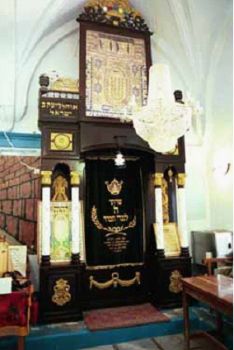
Synagogue Safed (Palestina/Israël)
1. Dora Bedak-Petenbaum (Jerusalem, 1 May 1887)
According to the German passport list of February 1943 (see below) Dora lived in The Hague (Sonderdankstreet 21, near Clingendaal). She lived there together with her husband, Herman Bedak (3 February 1887), also born in Jerusalem, and their presumable daughter Rebecca, who was born in 1915 in Bremen. All three had a Dutch alien passport. It is likely the Bedak family fled in the thirties to Holland. Dora's passport expired at 9 November 1939; her daughters' in June 1939, the alien passport of Herman Bedak only on 9 November 1941.
Dora Bedak-Petenbaum (56) was killed on 27 March 1944 in Auschwitz. As far as known, she is the only one of the 49 Turkish-Jews to be on two German lists of 1943 who dies in the Holocaust. Just like her husband she was one of the three of these 49, also mentioned in the telex by Zoepf. The Turkish authorities in Germany didn't recognize them any more as Turkish citizens. Together with Dora, from the Zoepf-group also Rachel and Isaac Jakob van de Kar-Mogroby, Esther Moreno-Peres, Sara Sorias-Benadereth and her son Alberto (daughter Carmen probably not) die during these days. Indeed they have been sent on with the first transport after the telex, on Tuesday 22 March 1944. Almost for sure they were immediately after arrival selected for the gas-chambers. Why the women and children all don't have the same date of death is unclear.
2. Ribca Chichou (Safed/Palestine, 23 June 1892)
Her name is on the transportlist to Bergen-Belsen of 13 September 1944. After her name her profession is mentioned, saleswoman, 'wahrscheinlich Turkei' (probably Turkey) and 'straffällig' (punishable). According to the site of the Jewish Monument her last address was the Witte de Withstreet 38-II in Amsterdam. Probably her nationality papers were obscure. She could have been punishable because she had been in hiding. Maybe that's why she wasn't transported to the Benadonlager. She died on 29 April 1945 in Hillersleben, 52 years old. Together with Irma Foerder (see below) Ribca was the only one from the transport who didn't survive the Shoah.
Mister 'Sjiso', who remembers Rob Mayer from a picture with his grandfather Jakob Mogroby (paragraph III), was probably her husband. Mr. Sam Behar (October 2005) writes 'the old gentleman Chichou' had a certain title in the Portuguese-Israelite synagogue (P.I.G.) and, just like singers and rabbies, wore a special hat. Descendants of the Chichou couple still live in Holland.
Hillersleben is about 20 km north-west of Maagdenburg. Mrs. Chichou must have been in the first train which left Bergen-Belsen because of the by Berlin ordered 'evacuation' of about 7,000 Hungarian, 'neutral' and other 'exchange-Jews', on Sunday 8 April 1945. The Benadon-group had already left a month ago. This train transported 2,400 people, 179 of them from Holland. The station of Bergen-Belsen was 8 km from the camp. People had to drag themselves to the station. The trains were infested with diseases, as well as many of the prisoners. The train drove criss-cross through Germany, attacked by allied planes, and was left by the guards five days later, not far from Maagdenburg. 'It had to be plunged into the Elbe with all hands'.
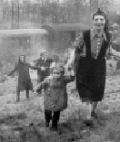
US-Commander C. Cross of the 743rd Tank Batallion and the 30st Infantry Division, saw the train, its starved passengers and imprisoned Finnish guards on Friday 13 April in a dale near a deserted station. The soldiers provided the liberated prisoners and Finns with food. Major Benjamin made pictures. Later many of them received medical attention in their camp at Hillersleben. Many died there or were already dead, and were buried next to the field hospital. Among them must have been Ribca Chichou. In the period after the war the place where the field hospital had been was transformed into a park. By doing of surviving relatives and the U.S. Commission for the Preservation of America's Heritage Abroad a cemetery was established in 1995. 62 identified victims have their grave there. In July 2000 some neo-nazi's played havoc at the cemetery.
3. Luna Cymbalist-Peres (Constantinople, 14 May 1897)
Together with her husband Simon (see below) and their presumable daughter Rosa she is mentioned in the telex by Zoepf. The Turkish authorities in Germany didn't recognize them anymore as Turkish civilians. The place of birth from the daughter shows the family lived in Berlin. Probably they fled, just like the Bedak family, during the thirties to Holland and had an alien document. Or played the Polish background of her husband a role? In April 1942 the family lived at the Doctor Smitstreet 5 in Zandvoort. Luna Cymbalist-Peres dies on or about 31 August 1944 in Auschwitz (47), on the same day as her husband and her daughter. Maybe they were, just like the couple Bedak, part of the transport of 22 March, but weren't selected for the gas-chambers immediately after arrival. Esther Moreno-Peres (Constantinople 1888) is also mentioned in the telex.
4. Rosa Cymbalis(t) (Berlin, 8 July 1927)
The name Rosa Cymbalist is mentioned in a website-remembrance of Hester Waas-Kool (1927) from Zandvoort (www.remember.org/children/koolsmom.html). She tells her parents and brother are summoned in the spring of 1943 for deportation through the Hollandsche Schouwburg. A friend of hers, who's already participating in the resistance, helps her to go in hiding. The friend was named Rosa Cymbalist. Rosa was killed at the same place and time as her mother, in Auschwitz on 31 August 1944. Rosa was 17 years old. Sam Behar remembers a family Cymbalist tried to get away via the roof-top; it could have been Rosa and her parents.

Camp (M. Cobelens coll. JHM)
5. Szymon Cymbalist (Warschau, 29 aug. 1894)
According to the site of the Jewish Monument Szymon was a porter. Together with his wife Luna (see above) and their daughter Rosa, they are mentioned in the letter by Zoepf. Szymon or Simon (OGS) dies on the same date as his wife, on 31 August 1944, just 50 year old. Not in Auschwitz though, but in 'Middle-Europe'. This could be the indication for a work camp.
A 'cymbalist' plays a 'cymbalon', an instrument which is very common in East-European gypsy and klezmer bands.
6. Irma Foerder-Austerlitz (Oberglogau, 17 April 1888 - ogs.nl says 1880)
Her last address was the Mauritsstraat 7 in Utrecht. Her name is on the transport list to Bergen-Belsen of 13 September 1944. Behind her name there's a note: 'without profession'. Together with Ribca Chichou (see above) Irma Foerder was the only one from the transport who didn't survive the Holocaust. She died in Bergen-Belsen on 8 November 1944, probably in the Benadon-Lager, within two months after arrival. She didn't live to be in the exchange via Zweden. Oberglogau is in Upper-Silezia, in 1880 belonging to the German Empire.
7. Max Friedman (Chestochowa/Czenstochau, 2 November 1895)
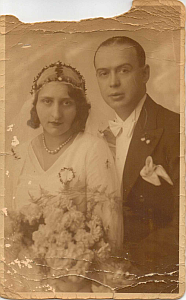

Max en Helene Friedman-Pipesberg. Left: wedding picture (ca. 1925), right: the couple with daughter Ruth. Pictures: family collection Mrs. Ruth Bornstein-Friedman (Hawaii)
On the sites of the War Grave Foundation and the Jewish Monument his name is written as Friedman. According to family pictures that proves to be the correct spelling.
Max Friedman married Helene Pipesberg (16 sept. 1905) in the 1920's. The couple got a daughter, Ruth. Max was a well known person in Amsterdam and The Hague. In that city he was 'chef de restaurant' ('maitre'), probably head of staff and servants, of a restaurant. That period he lived, according to his business card, on 1st van den Boschstraat 216, Bezuidenhout (The Hague).
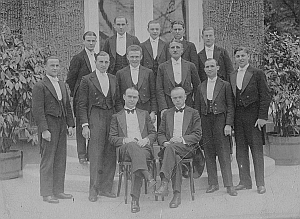
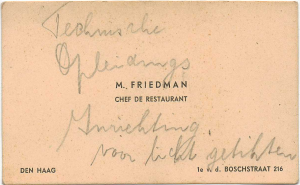
Left: Max Friedman, First row left. In Amsterdam? Right: Business card Max Friedman with joke ('Institute of Technical Education for slightly mad people' (1935?)) Pictures: family collection Mrs. Ruth Bornstein-Friedman (Hawaii)
In spite of its Turkish documents the Friedman family was deported and ended up in Bergen-Belsen. After the evacuation of the camp Max died on 19 May 1945 in Trõbitz, near Leipzig. Here one of the three 'evacuation' trains from Bergen-Belsen had stranded. Many Turkish Jews went to this camp. The first train ended up in Maagdenburg; the second in Theresienstadt and the third one got lost. It was mentioned as the 'lost train'. Fortunately the train sometimes stopped, so the healthiest passengers could search for food and water. Many passengers suffered from spotted typhoid. Many people died, but less than on other 'death marches'. On 23 April 1945 the train stopped. It was in the village Trõbitz in Niederlausitz, sixty kilometers from Leipzig. There were Russian liberators. Most of the passengers needed medical attention. Some of them in Leizpig, at that time in American hands. After two months, according to the estimate of Joep Weiss, 1,900 from the original 2,500 passengers were still alive. Max Friedman didn't survive the evacuation. See above (at Ribca Chichou) for the story of the Maagenburg train.
Helene Friedman-Pipesberg and her daughter Ruth survived the Shoah and emigrated to the US. Helen married Victor Sorias, who like her was a Jew with Turkish documents. With her daughter Ruth and his daughter Carmen (who probably survived as well) they founded a new family. For more information, see Sorias.
Extra sources: Mrs. Rosa Vega (USA), September 2011; www.joodsmonument.nl; www.familysearch.org/Eng/Search;
8. Abraham Goldberg (Frankfurt am Main, 9 June 1896)
His last address was Sarphatipark 105-III in Amsterdam. Abraham Goldberg is named first in the telex by Willi Zoepf. The Turkish authorities don't recognize him anymore as a Turkish citizen. He dies on the same day and place as Simon Cymbalist, on 31 August 1944 in Middle-Europe. Maybe they were also part of the transport of 22 March, but weren't selected for the gas-chambers straight away.
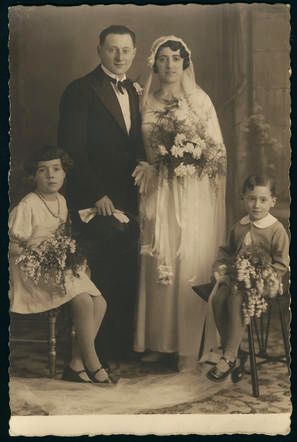
Wedding picture Rachel Mogroby and Isidoor van de Kar (www.joodsmonument.nl)
9-10. Rachel ('Elly') van de Kar-Mogroby (Amsterdam, 31 October 1906) and Isaac (Isaak) Jakob ('Freddy') (Amsterdam, 7 June 1937)
Together with the name of her husband Isidoor and their son Isaak her name is in the telex by Willi Zoepf. The mentioned date of birth there from 'Isaak' (7 June 1931) must be 7 June 1937. Rachel and Isidoor married on 14 February 1934. Little Isaac Jakob was in his second name named after grandfather Mogroby. A picture of him and his mother can be found in III, Mogroby. The last address of the family was Cornelis Anthonieszstraat 73-II in Amsterdam. On 3 April Isidoor was sent to camp Westerbork.
On 1 January 1943 the nazi's, in a letter to Ankara, cancel the 'unique position' of the Turkish-jewish group. The Turkish state also was already busy to make things hard for their citizens abroad. According to Turkish law anyone who had not been in Turkey for over five years, could lose his or her Turkish nationality.
In spite of this on 4 April 1943 Isidoor asks from Westerbork through the Jewish Council (JC) also for a 'Sperr-stempel' (stamp to prevent deportation) in his identity card (IC) for himself, because of the double nationality of his wife. Her Turkish nationality can be seen on Rachels IC and on an excerpt from the Register of births, deaths and marriages, which the Turkish Consulate validated. Permission though, is also needed from the German Expositur. The procedure of the request can be followed through the dates stamped on Isidoors JC card between 8 April and 10 August. On the JC-card of Rachel a decision by the German authorities can be read: 'Repatriation to Turkey according to list Expo(situr) 24-8-43'. Exceptional, unknown Turkey instead of Westerbork. Only she? Or also Isidoor and Freddy? Below is the final answer: 'further actions no purpose, 2.2.44.' Despite previous correspondence, preventing deportation to the East had not been successful. Rachel remained stateless. Meanwhile she also seems to be held detained in Westerbork. On top of her card is the date of 4 November 1943.
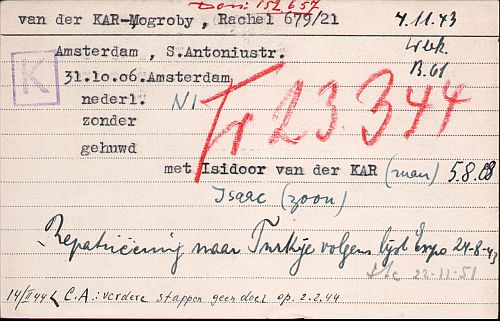
Card of Elly van der Kar-Mogroby from the Jewish Council (Arolsen Archives)
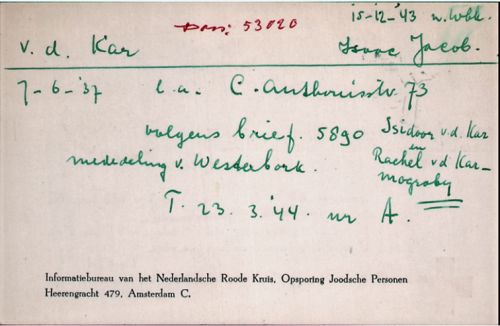
Card of Isaac Jacob from the Red Cross (Arolsen Archives)
According to his card from the Red Cross, 'Tracing jewish persons' 'Isaac Jacob' is only registered on 15 December in Westerbork.
Rachel and Freddy are deported on 23 March and they die on 26 March 1944 in Auschwitz. On the same day and place as Dora Bedak-Petenbaum, Esther Moreno-Peres, Sara Sorias-Benadereth and her son Alberto (daughter Carmen probably not), during the days 25-27 March 1944.
For the fate of Isidoor see below.
With thanks to Fred Seesing, volunteer at the Arolsen Archives (D), who sent us in December 2021 a link to additional documents in the Archive: e-Guide Arolsen Archives (arolsen-archives.org), and who supplied the concept with additions and corrections.
Another woman mentioned in the telex by Zoepf, Friederike Monas-Mogroby (Vienna 1900), was a sister of Rachel (see below) as well as Lea Mayer-Mogroby (Amsterdam 1912) who is on the passport list.
On the website of the War Graves Foundation, besides Rachel van de Kar-Mogroby, there are 4 other victims of the Shoah with the name Mogroby. Their names aren't mentioned in the telex of 17 March or in other name lists. In paragraph III there is information and pictures from a large number of family members. They are:

Damascus, Ommayaden mosque
9a. Jacob Meyer Mogroby (Damascus, 14 April 1870), died in the surroundings of Auschwitz on 6 September 1944 (age 74). The family knows him as Jacob Meijer. From his first marriage there were the children Mozes (Alexandria, 1898), Friederike (Vienna, 1900), Rachel (Amsterdam, 1906) and Lea (Amsterdam, 1912). Jakob Meyer Mogroby and his family came in 1901 from Vienna to Amsterdam. Ruijschstraat 86-hs was their last address.
9b. Johanna Mogroby-de Wolff (Stad Delden, 27 May 1881), died in Auschwitz on 6 September 1944 (age 63). She was the second wife of Jacob Meyer.
9c. Mozes Mogroby (Alexandria, 10 February 1898), died in (prob.) Auschwitz in September 1944. He was the father of:
9d. Alfred Mogroby (Vienna, 18 October 1921), died in a labour commando of Buchenwald, Weimar, on 1 December 1944.
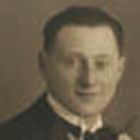
Isidoor van de Kar
11. Isido[o]r van de Kar (Amsterdam, 5 August 1908).
The family knows him as Isidor. According to the website of Jewish Monument he was a typographe.
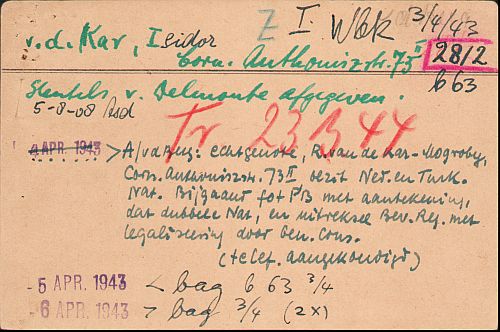
Card of Isidor van de Kar from the Jewish Council (Arolsen Archives)
Isidor was arrested on 1 April 2943 and transported to Westerbork where he arrives on 3 April. Rachel was probably imprisoned there on 4 November. On the card from the Jewish Council of Isidor a 'Z' is written which means 'Zurückstellung' (deportation to place of origin). Pending the developments and arrangements between the nazi's and Turkey, Isidor stayed in Westerbork for a long period of time. For the correspondence with the Jewish Council see above (nr. 9-10).
On 16 March 1944 Willi Zoepf, working for the Sicherheitspolizei and Sicherheitsdienst in The Hague and responsible for the transports, writes a letter about the Turkish group to the camp authorities in Westerbork. He orders commander Gemmeker to treat as 'stateless' and 'to put them on the first transport for "relief work" to the East.' With in total 599 jews from Westerbork they arrive on 25 March in Auschwitz. 239 of the group, among them Rachel and Freddy, are instantly sent to the gas chambers. Isidor is selected for work and transported to Buchenwald at the end of the year.
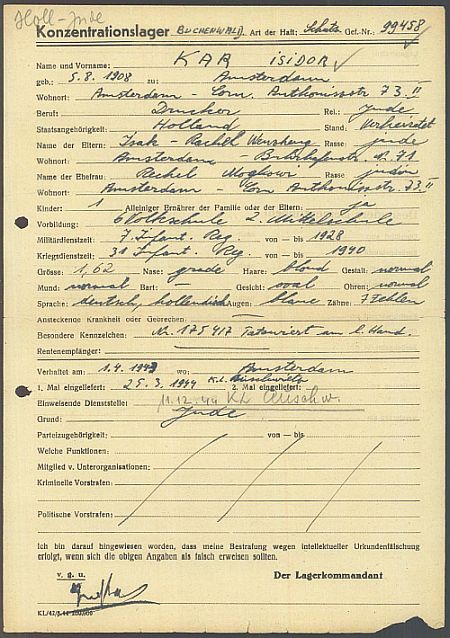
Staff page Isidor van der Kar KZ Buchenwald (Arolsen Archives)
On 22 December 1944 he is registered here. According to his staff page he is not tall, 1.61 m. His nose is straight and his eyes are blue. His appearance is 'normal' with the exception of his mouth, where 7 teeth are missing. This was also so in Auschwitz. One wonders what happened. On cards he is specified as 'political prisoner', what could indicate resistance. Isidor had served in 1928 and again in 1940. On his left hand his Auschwitz number is tatoed (175417). Isidor is employed in Kommando Langensalza. This concentration camp was situated in Bad Langensalza, Unstrut-Hainich district. It was an outside camp of Buchenwald and served the Junkers firm between December 1943 and April 1945 as a production facility for aircraft parts. The deported Jews were under supervision of the SS as cheap labour force.
Probably on 11 December 1945 Isidoor was transported to KZ Mittelbau-Dora - there also is a date of 30 January 1945. This concentration camp near Nordhausen, south of the Harz Gebirge, came into operation in August 1943. First Lager Dora was an 'Außenlager', outside camp, of Buchenwald, but in the summer of 1944 it became an independant camp itself, with about forty 'Außenlager'. Everything was aimed at supporting the German war industry. Prisoners were held under a merciless regime and 'used up' at the production of V1's and V2's.
Isidor van de Kar died in 'Middle-Europe', on 9 May 1945, a day after the German capitulation.
Extra source: Guus Luijters, Aline Pennewaard, In Memoriam, De gedeporteerde Joodse en Roma en Sinti-kinderen 1942-1945. Nieuw-Amsterdam 2012, p. 753-755.
With thanks to Fred Seesing, volunteer at the Arolsen Archives (D) - also see above at 9-10.
12-13. The couple Benjamin Monas (Amsterdam, 21 July 1893) and
Frei[ie]derika Monas-Mogroby[ij] (Vienna, 15 January 1900)
The family knows her as Friederike. The Holocaust-sites spell her name as Mogrobij. Benjamin was a diamond cutter. The last address of the family was the Valckenierstraat 17a-I. The couple dies five weeks before the telex by Zoepf, on 11 February 1944, in Auschwitz. He's 51, she 44. The names of the couple are together with the name of their son, Jacques Benjamin, with the first group in the telex. The son, 17 years old, survived by jumping from the train. It isn't clear why the couple was deported before the official 'permission'.
For other family members see Rachel van de Kar-Mogroby. Alfred Mogroby was also born in Vienna, in 1921.
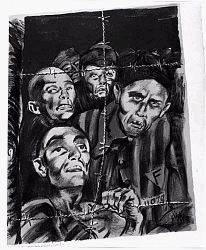
Buchenwald (H. Pieck, coll. JHM)
14. Esther Me[o]reno-Peres (Constantinople, 14 August 1888)
Esther was a widow. Her name is in the telex by Willi Zoepf. Turkish authorities no longer recognized her as a Turkish citizen. She dies in Auschwitz, on 26 March 1944. During the same period as Dora Bedak-Petenbaum (27 March), Rachel and Isaac Jakob van de Kar-Mogroby (26 March), Sara Sorias-Benadereth and her son Alberto - daughter Carmen probably not - on 25 March. Almost certainly they were selected for the gas-chambers immediately after arrival. Why the women and children all don't have the same date of death remains obscure. Luna Cymbalist-Peres (Constantinople 1897) is also mentioned in the telex.
15. [Jecheskel] Josna [Josua] Neubauer (Würzburg 26 November 1924)
He is, with his father and mother, in the second group of the telex by Zoepf. He died 9 September 1944 in Bergen-Belsen (age 19).
16. Jakob Neubauer (Leipzig, 29 January 1895)
Teacher Dutch-Israelite seminary in Amsterdam. His last address was Nieuwe Prinsengracht 28-III. His name and the name of his wife Rosalie (Galicia 1895) and their son Josna (see above) is in the second group of the telex by Zoepf. They were made stateless by the German instead of the Turkish authorities. Jakob died in Bergen-Belsen, on 22 March 1945. Bergen-Belsen partly was an exchange-camp. The family probably had papers for Palestine and therefore could escape deportation to Auschwitz. The name of his wife isn't in the register of the War Graves Foundation. She probably survived Bergen-Belsen. According to the site of the Jewish Monument there were three other children, who also survived. One of them was Mirjam Neubauer (Wiesert, 31 May 1923). Her name is on the passport list of 1943 with the same address as her parents. In handwriting is addes: "Hat keine Papiere, ist vermutlich Staatenlos." (Has no papers, probably stateless). Even so Mirjam survived.
Jakob Neubauer and his family fled in 1933 from Germany to Amsterdam. He played an important role in the development of the Dutch Israelite Seminary and in the religious revival in Jewish Holland. He was a highly regarded teacher (M.H. Gans, Momorboek, Baarn 1988; www.joodsmonument.nl). On a website with names of famous rabbies and jurists in Würzburg at number 69 teacher Jakob Jekutiel Neubauer is mentioned. He was 'seminary-rabbi' (ILBA) in this city (www.shalomeuropa.de/s_g_pe_02.html).
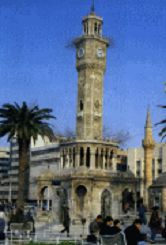
Saat Kulesi (city clock) Smyrna (picture: www.ourfatherlutheran.net)
17-19. Sara Sorias-Benadereth (Smyrna, 1 January 1910) and her children Alberto (Milano, 22 April 1931) and Carmen (Amsterdam, 13 June 1940).
Their names are, together with their fathers', Victor Sorias (Lannaca/Larnaca, 10 December 1906) with the second group in the telex by Zoepf. They were declared stateless by the German authorities. Mother and children - probably not Carmen - died in Auschwitz, on 25 March 1944. She is 44, her son almost 14. During that same period Dora Bedak-Petenbaum (27 March), Rachel and Isaac Jakob van de Kar-Mogroby (26 March), and Esther Moreno-Peres (26 March) also die in Auschwitz. They were part of the first transport after the telex of 17 March. Almost certainly they were selected for the gas chambers immediately after arrival. Why these women and children do not have the same date of death remains obscure. The man and father survived selection and camps, like Carmen did probably too. Mr. Sam Behar knew the family well. He calls Sara a 'very beautiful lady'. He played together with Alberto and Carmen. Victor Sorias remarried after the war and moved to America.
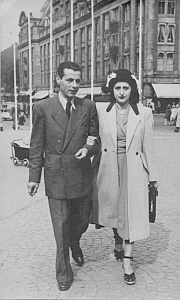
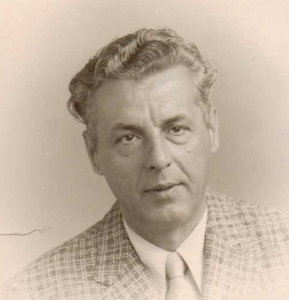
Left: Victor Sorias and Helene Friedman on Dam Square in Amsterdam (ca. 1946). Right: Victor Sorias in the USA (ca. 1960) Pictures: family collection Mrs. Ruth Bornstein-Friedman (Hawaii)
Victor Sorias after the disaster married the widow of Max Friedman, Helene. She survived the Shoah together with her daughter Ruth, like Victor did with his daughter Carmen - according to a friend of the family. Family pictures show Victor Sorias, Helene Sorias-Friedman and a girl who has the age of Carmen. They are on holiday around 1950 in Milan, where Victor's son, Alberto, had been born in 1931. The new family emigrated to the US. There Victor died on November 20, 1964. Ruth married Mr. Bornstein. Helen remarried Leon Schmidt, who originally came from Berlin (see picture). She died on November 28, 1999. Ruth Bornstein became a widow. When she moved to another house, the removing firm found a box with family pictures, meant to be thrown away. The firm did not do that. In a conversation with Ruth Bornstein her life story came to life. After that encounter the contact with Ruth went lost.
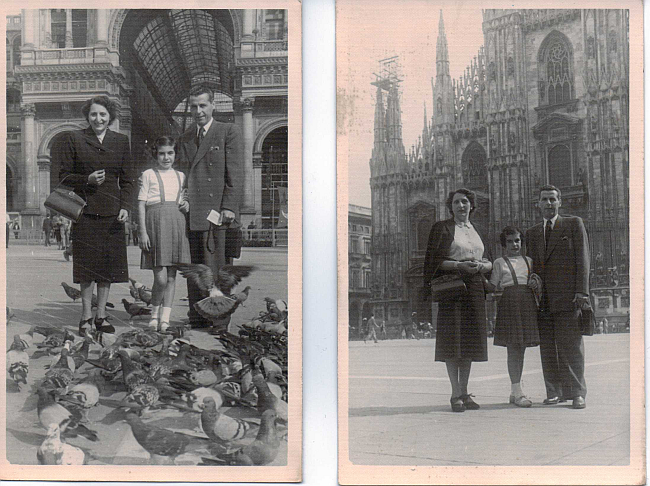
Helene and Victor Sorias-Friedman with probably Carmen Sorias in Milan (ca 1950). Pictures: family collection Mrs. Ruth Bornstein-Friedman (Hawai).
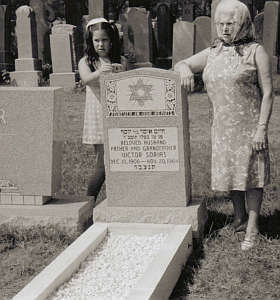
Family members at the grave of Victor Sorias. The older woman is Lonia Schmidt. The little girl with the small stone is a granddaughter of Helen Pipesberg. Pictures: family collection Mrs. Ruth Bornstein-Friedman (Hawai).
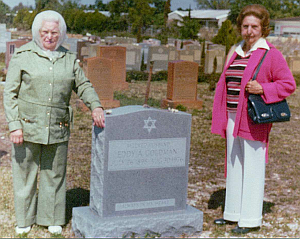
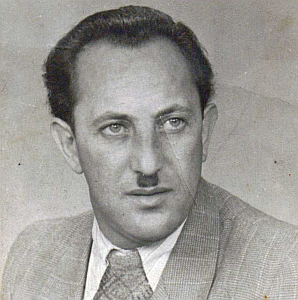
Left: Family members at the grave of a friend. The woman at the right hand is Ruth Bornstein-Friedman. The woman left is Lonia Schmidt, probably a sister of Helen Piesberg's third husband. Pictures: family collection Mrs. Ruth Bornstein-Friedman (Hawaii).
Extra sources: Mrs. Rosa Vega (USA), September 2011
A probable relative of the Sorias family is in the register of the War Graves Foundation for another reason. It is Abraham Sorias, born in Izmir (4 June 1922). He was a conscript to the Dutch Army but stayed in South-Africa. He was a member of the 7th South-Africa Detachment which tried to join the Princess Irene Brigade. Aboard the steamer Abosso II, which brought civilians and recruits (English and Dutch) from South-Africa to Liverpool, he died on 29 October 1942, in the north of the Atlantic, 1,100 km north of the Azores. The German submarine U-575 torpedoed the slow ship. At least 168 crew and 83 passengers (probably many more) lost their lives. Among them were 50 members of the 7th Detachment; one of the falls of their lifeboat (nr. 3) was held on, the boat crashed and all men drowned. Only 31 persons on board were saved, after three days in a leaking sailing sloop, by the British corvette HMS Bideford. Abrahams name is on a memorial in the garden of the Dutch Embassy in Pretoria, South-Africa. For a picture of the memorial click here.
II. Names from victims on the two victims websites (29)

Jaffa around 1890, Bonfils
This concernes the names of Jewish people who were born in one of the main cities of the 19th-/early 20th-century Ottoman Empire, and for that reason in 1940-1945 probably had identity papers from the neutral state of Turkey.
On the Shoa-memorial site a number of obvious places of birth and dates have been checked; among it all 'Ottoman' cities in todays Turkey, Macedonia, Syria, Israel/Palestine and Egypt, which are known from the German documents.
This way another 25 Shoa-victims with a possible Turkish background were found. Added to it are the four members of the Mogroby family who received the numbers 91a-d in the first list of names. It can be presumed the ones who were deported before 1944 to one of the destruction camps, had no protecting documents as viewed by the Germans. Their names are in italic (15), the names of the later on deported (14) are in bold.
1. Laura Caroline Berent-Rothschild, born in Alexandria (Egypt) on 26 January 1891. Last address: Graafscheweg 207 in Nijmegen. Died on 12 February 1943 in Auschwitz (52 years old). Her husband, Johan Martin Ludwig Berent (Berlin 1889), merchant, was murdered at the same place and date. Their son Peter Max (ditto 1922) died on 31 March 1944 in Auschwitz.
2. Rachel Berger, born in Jaffa (Palestine) on 26 October 1898. Last address: State Mental Institution in Eindhoven, Boschdijk 771. She is the fourteenth name on a list of nineteen people who were killed in the Shoah - sixteen of them on the same day as Rachel. Died on 26 March 1944 in Auschwitz (45 years old).
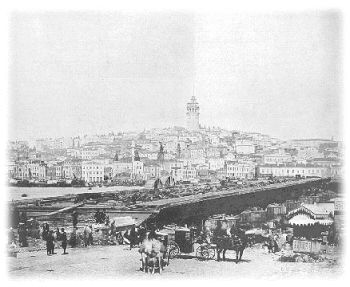
Istanbul, Galata-bridge with Galata-tower under construction
3-5. Frances family:
Liaho/Liako ('Eliahu') Frances, rabbi. Born in Saloniki on 17 December 1878 (Turkish Empire). His wife Dimiandi ('Diamante') Frances-Tazartes, born in Saloniki on 31 August 1881. Their son Daniel Frances, born in Saloniki on 9 February 1906. Mr. Sam Behar writes there was a daughter Dora and two more sons: Maurice and Jacques. They survived, as did the husband of Dora, dr. Bloch. Behar also writes the family spoke Ladino with a non-Turkish but Greek accent. Rabbi Frances assisted around 1930 in Amsterdam at the marriage of Salomon ('Salamon') Behar (1903) and Dudu Kuzi (1900), both born in Adrianople (Edirne), the parents of Sam Behar. The last address from the couple Frances-Tazartes was Plantage Parklaan 2-II in Amsterdam. Daniel Frances, shop assistant, lived during the war with his wife and child in the Plantage Franschelaan 7-II. Rabbi Eliahu Frances (63 years), his wife Diamante Frances-Tazartes (60 years) and their son Daniel (36 years) died on 28 September 1942, probably in Auschwitz, ten weeks after the start of the deportations. Daniels wife, Clara, and their son Elie survived. The Holocaust-sites write Mr. Frances died in Monowitz, a labour camp of Auschwitz.
6-8. Semaria Gabay family: [information by Ad van den Oord, e-mail 13 April 2005 and 19 February 2010].

Wedding picture couple Gabay-Smeer (source: joodsmonument.nl)
Semaria ('Mario') Gabay, born in Istanbul (Turkish Empire) on 16 November 1915 (OGS) or 30 April 1915 (Site ~dutchjew). The last date could have been confused with the date of birth of his daughter. His parents were Joseph Gabay and Sarah Ojalvo. Semaria Gabay was a carpet salesman and lived during the war in Haarlem at the Grote Houtstraat 104-106. On 23 April 1942 Semaria married Dina (Bobby) Smeer, born in Amsterdam 26 July 1918, who was an office clerk. A picture of their marriage has been kept. In February 1941 she is stated as living with her parents, the musician Meijer Smeer and Branca Smeer-Degen, at the Tugelaweg 55-III (Transvaal district). They are gassed on 18 January 1944 in Auschwitz.
The cause was treason by Branca Simons, a relative and also Jewish. Branca ran into her niece Dina early January 1944 in Amsterdam. At that time Dina, with her seven months old daughter Serica, was in hiding in Hotel Trianon. Branca draw her out and found out that Dina had an appointment for a new hiding adress. She passes this information on to her contact at the Sicherheitsdienst, Pieter Schaap. He arranged mother, child and helper are arrested, as well as Dina's parents (source: Sytze van der Zee, Vogelvrij, p. 350). They immediately were put on transport.
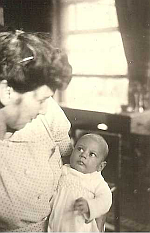
Bobby and Serica Gabay (source: joodsmonument.nl)
Serica (Cerica) Bianca Gabay, born in Amsterdam or Alkmaar on 30 April 1943 (see picture above), dies in Westerbork on 28 February 1944, eleven11 months old and was buried at the Portuguese-Israelite cemetery in Ouderamstel. Semaria (nr. 28) and Dina (nr. 27) were part of the last transport from Westerbork to Auschwitz, on 3 september 1944. They did not go to the Benadon-Lager in Bergen-Belsen, like many other Turkish-Jews. Dina Gabay-Smeer died in Auschwitz on 31 October 1944 (25 years). Semaria Gabay died in Middle-Europe, probably in a labour camp, on 15 March 1945 (29 years).
It is possible the Gabay-Smeer family possessed Turkish papers, though they finally didn't protect them. Going into hiding was a criminal offence. Their presence in Westerbork in the spring of 1944 is coherent with the messages in the diary of Philip Mechanicus (see paragraph IV, Backgrounds). Their adress is the same as the address from the two persons on the German passport lists of February 1943: Fani ('Fanny') Hatem-Capuano (Istanbul, 21 May 1881) and Albert Hatem (Istanbul, 27 August 1913), mother and son. Albert was the owner of the shop in Oriental carpets and formally lived in Haarlem, also when both went into hiding in 1943 in Amsterdam. This way the fellow-citizens of Semaria Gabay survived the Shoah.
9-14. Hirsch Higes, born 11 March 1885 in Jerusalem (Palestine). Merchant. His last address was the Van Limburg-Stirumstraat 36 in The Hague. There he lived together with five relatives, probably his wife Itta Hoges-Schõnberg (Warsaw 1892) and their children Avigdor (Amsterdam 1918), Raphael (ditto 1920), Nehemia (ditto 1923), and Frieda (ditto 1924). Hirsch and Itta Higes died, just like Raphael and Nehemia, on 21 May 1943 in Sobibor (58 years). They were 58 years, 51 years, 23 years and 20 years. Frieda died on 30 November 1943 in Trawniki, an exernal labour camp of Sobobor, 21 years.
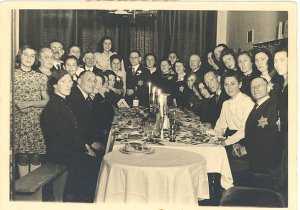
The wedding, with Stars of David, of Avigdor and Rebecca, on 9 September 1942. Rebecca's father, mother and sister already are deported and murdered (8 August 1942). Avigdor is standing at the end of the table, left from the middle, with Rebecca in her wedding gown at his side. The family on the left hand side could be the Higes-Schõnberg family. (Click on the picture to enlarge) (Source picture: www.joodsmonument.nl)
15-17. Avigdor Higes, furrier, and his wife Rebecca de Jongh (Amsterdam, 28 november 1923), teacher, were in November 1943 in Westerbork. On 3 November their son Uriël Jehuda was born there. For a little while the family might have been protected by a Turkish nationality. They were in the last transport to Auschwitz, on 3 September 1944, with the number 60-62. Immediately after arrival Rebecca and Uriël were selected for the gas-chambers, where they died on 6 September. Avigdor lived until after the German capitulation, but died on 9 May 1945, in an unknown place in Middle-Europe.
18-19. Lisa Ladrer-Mayer, born on 17 May 1900 in Constantinople (Turkish Empire). She was married to Alois Ladrer (Vienna, 19 September 1886), merchant. Their last address was Stadionweg 98 II, where they lived together with two more households. According to the place and time of their death it is possible Lisa, and probably her husband, had Turkish papers. Alois Ladrer died in Bergen-Belsen, on 17 January 1945. Lisa Ladrer-Mayer died on 26 April 1945 in Trõbitz (44 years). Her death in Trõbitz also means Mrs. Ladrer was in 1945 in Bergen-Belsen. Trõbitz is the place near the Elbe where the third 'evacuation' train from the camp stranded after many days firing and wandering. Max Friedmann (Czestochowa 1895) - see the first names list - and Margarete Siliava (Cairo, see below) also died in Trõbitz.
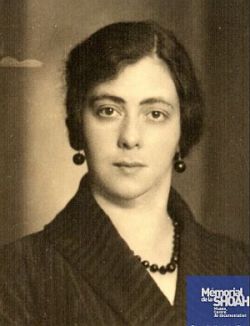
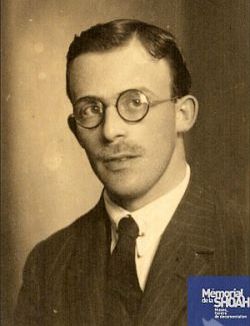
Fortunée Zavarro and her husband Maurice van Meer (pictures: www.memorialdelashoah.org)
20. Fortunée van Meer-Zavarro was born on 20 December 1895 in Constantinople (Turkish Empire). She died on 5 September 1944 in Auschwitz (48 years). Her place of birth and late death could mean Mrs. Van Meer had Turkish papers. Her name is not mentioned on the list of the last transport to Auschwitz, on 3 September 1944.
Fortunée Zavarro was already deported earlier, not from Westerbork but from French Drancy. She lived with her husband, Maurice van Meer (Maastricht, 6 Oct. 1895), in Brussels, 39 Rue de Lombard, and fled with him during the war to Montpellier, where they stayed at Chemin de Sauret, probably Avenue Saint-Marice de Sauret. In all probability they were arrested there in June 1944 because of being Jewish and send on to the French deportation centre.
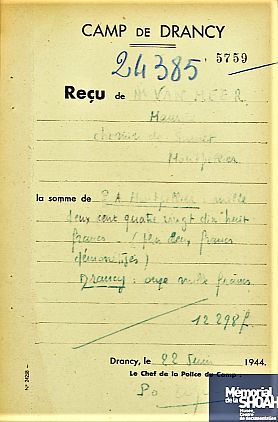
When being searched in Drancy Maurice the camp police confiscated, according to a receit 11,000 Francs, after he already had to hand over 1,298 Francs in Montpellier (including two void 1 Franc coins). From Drancy both were deported with transport 76 to Auschwitz on 30 June. Fortunée lived there for two more months. Her husband Maurice survived the shoah.
With thanks for the information about the transport list to Lucas Bruijn (January 2012), and to Mrs Carla Berkhout for her links to pictures and documents of the Paris Mémorial de la Shoah (December 2021).

Arrival in Auschwitz (picture: coll. JHM)
21. Alfred Mogroby (Vienna 1921 - Buchenwald December 1944)
22. Mozes Mogroby (Alexandria 1898 - Auschwitz September 1944)
23. Jacob Meyer Mogroby (Damascus 1870 - ditto)
24. Johanna Mogroby-de Wolff (Stad Delden 1881 - ditto).
For members of the Mogroby family see the names list above (9a-d) and paragraph III.
25. Margarete Siliava, born on 30 September 1911 in Cairo (Egypt). Died on 28 April 1945 in Trõbitz (33 years). Her last address was Herengracht 232-II in Amsterdam, her profession was housekeeper.
The name of Margarete is last (nr. 55) on the transport list of the train that left Westerbork on 13 September for Bergen-Belsen. Margarete is one of the four persons who won't survive. As her profession 'Kindergärtnerin' (nursery teacher) is noted. Regarding the nationality: 'wahrscheinlich Ägyptisch' (probably Egyptian) is noted. According to the late date of deportation and the kind of camp, Margarete will have had protection for some time because of her foreign nationality. She died in Trõbitz, two days after Mrs. Ladrer-Mayer from Constantinople (see above). Max Friedmann died there on 19 May.
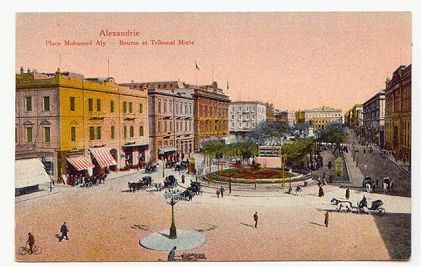
26. Paul Stern, born on 2 April 1903 in Alexandria (Egypt). Legal adviser. His last known address is Hondecoeterstraat 9-I in Amsterdam. There he lived together with his aged parents, Harry Stern (Oberstein, 26 July 1865) and Julie Regina Stern-Darnbacher (Karlsruhe, 7 June 1875). They die in Sobibor on 16 April 1943 (75 and 65 years old). Paul Stern probably also was murdered in Sobibor on 21 May 1943 (30 years).
27. Joseph Tuvy, born 14 November 1888 in Jaffa (Palestine). His last known address was Cornelis de Wittstraat 20 in Wassenaar. On 7 January 1943 the police of Wassenaar requests tracing, arrest and bringing in of Joseph Tuvy. He had left town 'without the proper required permission'. This description was used to describe Jews in hiding. Joseph was found very quickly. He died on 14 January 1943 in Auschwitz (54 years).
Another bearer of the name Tuvy is Leon Haim, born in Bukarest, on 23 April 1860. He lived at the Larikslaan 149 in Rotterdam (until December 1941 Eikenlaan 149 Schiebroek). Died in Auschwitz on 11 February 1944. If Leon Haim was family Joseph Tuvy perhaps had a Romanian passpoort. A foster son of Leon, with children, lived in the same house and survived.
[With thanks to Anton Stapelkamp, Rotterdam, February 2009]
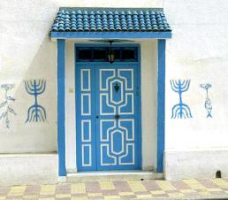
28. Elie Valensi, born on 15 May 1881 in Tunis (in present-day Tunesia). He belonged to a Jewish family from Livorno (Italy). Elie married around 1919 to Marie Joséphine Krief, daughter from a Tunesian Jewish family. In the course of 1881 Tunesia had, first as part of the Ottoman Empire, become a French protectorate. Elie and Marie therefore considered themselves to be French. Their medium of communication was French and so was their nationality. The couple moved to Paris. There Elie set up a leather and shoes company. Also their children, Simone Rachel (15 May 1920) and André (1922/3), were born. Around 1925 the company went broke and the couple got to rack and ruin.
Netherlands
A befriended business partner, George Dubois, lived in the Netherlands. Around 1918 he had deserted from the French army and fled to the Netherlands. Dubois meant he could help them. The family settled in Schiedam and lived, especially in the beginning, in very poor conditions. In this town they befriended a French speeking Dutch family: the Schotman family. The lady of the house, Marie Schotman-Dubois (not related to George), was Walloon and never managed to speak Dutch. During these years Simone Valensi fell in love with their son, André Émile Schotman. They engaged in 1939/1940. Just before nazi-Germany invaded the Netherlands, Elie's wife and children took the opportunity, as French subjects, to be evacuated. They ended up in Casablanca.
French passport
Unfortunately Elie Valensi chose to stay in the Netherlands. Probably he wasn't aware of any real threat at that moment as he was a Frenchman, not religious and not following any Jewish tradition. In addition there was a personal drama. Things didn't work out well anymore between Elie and Marie Joséphine. The bankruptcy and the following poverty will have contributed to it. This was a opportune moment to be divorced. Especially because wife and children were accompanied by another Frenchman living in Schiedam (Pierre Rossignol) with whom Marie Joséphine already for some time had an openly amorous relation. They married a few years later in Casablanca.
Auschwitz
Unfortunately this sailing happened to be the last possibility to flee. After his wife and two children had left, Elie seemed to have visited his friend H. Dubat who wasn't leaving Holland either and who lived in Gouda. Presumably he was sent from there to camp Westerbork. Elie Valensi was in one of the early transports and was gassed in Auschwitz on 24 September 1942, at the age of 60.
Casablanca
The designation for the evacuation ship was Le Havre. From there Marie, Simone and André Valensi, through wandering, ended up in Grenoble. There didn't feel safe enough. A couple of months later they were able to flee to Casablanca. A lucky choice. Casablanca seemed to be a very good place to escape the war, also - and maybe especially - because of the brave position of king Mohammed V regarding Moroccan Jews. With his "Ne touchez pas &#aacute; mes juifs!" he refused to enforce the anti-semitic rules of the Vichy regime, let alone extradite Jewish subjects to nazi Germany (also see the paragraph Morocco on this site). During the war Simone Valensi worked as an interpreter with the Dutch agency. She also worked as an interpreter and secretary with the American army base. During the war André Valensi joined the French resistance in the Alpes and returned after the war to Morocco. Casablanca was so much to their liking that he and his mother stayed for over 15 years after the war.
Back
At the end of 1945 Simone Valensi returned to the Netherlands to marry her fiancee André Émile Schotman in 1946. André Schotman died in 1985, Simone Valensi in 2006 (14 December).
(With thanks to Simone Rachel Schotman-Valensi and Charles Schotman, The Hague, December 2006)
29. Karl Ludwig Arthur Zander, born on 14 August 1900 in Istanbul (Turkish Empire). Office clerc. His last known address is Diezestreet 29-II in Amsterdam. There he lives together with his wife Annette Zander-Monasch (Gouda 1908) and their three children: Hedwig (Amsterdam 1931, Robertine Suzanne (ditto 1934) and Frans Koert (ditto 1938). The entire family was gassed on 2 July 1943 in Sobibor.
III. Memories and pictures of the Mogroby family
Also seek I, 9-13
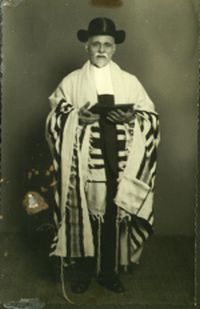
Jacob Meyer Mogroby
Jacob Meyer Mogroby was born in Damascus (14 April 1870). At that time Syria was part of the Turkish (Ottoman) Empire. His mother died when he was almost 13 years old, his fahter two months before his birth. Jacob was raised by his oldest brother. The family name Mogroby is derived from the Hebrew word maarab, which means 'west' and probably indicates the 'the western temple wall'.

Couple Mogroby-de Wolff
As a young man Jacob emigrated to the United States, where he received American citizenship on 23 October 1895. He US-passpoort would expire 1937. Arond 1896 he returned to Europe, where he marries in 1897 in Vienna Taube (Toni) Goldstein, originating from 'Lemberg' ('Llow') in Galicia - at that time Austrian, afterwards Polish and nowadays Oekrainian. The couple went on their honeymoon to Alexandria, where their first child was born, Mozes (1898).

Mozes Mogroby
In Vienna Friederike was born (1900), the other six children in Amsterdam, where the family had moved in 1901. Five girls and a boy, all with biblical names: Sara (1901), Abraham (1902), Rebecca (1904), Rachel (1906), Anna (1909) and Lea (1912). Jacob Meijer Mogroby was a pious man and active in the Portuguese synagogue. He had many professions. In Amsterdam for instance he worked as a bread roundsman.
Toni Mogroby-Goldstein died on 31 May 1925. Jacob remarried Johanna de Wolff, born in Stad Delden (1881). Their last known address was Ruyschstraat 86-hs in Amsterdam. Both are on the list of the last transport from Westerbork to Auschwitz, on 3 September 1944. They have the numbers 94 (Jacob) and 95 (Johanna). They died in or in the surroundings of Auschwitz on 6 September 1944. Jacob Meyer was not an American citizen anymore, and his name is not on the list of the four German lists with Turkish-Jews from 1943-1944. It looks like the family was in fact stateless.
From the children Sara, Abraham, Rebecca and Anna married a non-Jewish partner. Rebecca emigrated to the US. They all would survive the Shoa. Rob Mayer knows his uncle Mozes arranged Turkish documents for the non-mixed married family members. Unfortunately this didn't lead to success for most of them.
Mozes, the oldest, married Zillia Jacobi and became an antiques dealer; during the thirties he had his shop at the Spiegelstraat nr. 11. They also lived there.
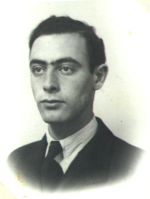
Alfred Mogroby
Maurits and Zillia had a son, Alfred, born in Vienna (1921), where his mothers family lived and a daughter Sonja (Amsterdam 1923). According to the antiques dealer who lived at the address during the fifties, Mr. Bill (1921), the Mogroby business was a shop with a lot of oak wood, stained glass, tiles and tin objects, Dutch Golden Century atmosphere. For a long time there was a crosswindow in the shop, and a special dolls house. Maurits (Maup) started living in the house around 1933 and payed a high rent of 180 guilders per month.
Zillia and her daughter would survive; her husband and son did not. None of them is on one of the four German lists with Turkish citizens, but their names are on the list of the last transport to Auschwitz, on 3 September 1944. Mozes had nr. 96, Zillia nr. 97 and Alfred nr. 93. Mozes died, just like his father and second mother, in September 1944 in Auschwitz. Alfred was in hiding but not carefully enough and was arrested. He died on 1 December 1944 in a labour command of Buchenwald. Zillia survived the Frauen-Arbeitslager in Liebau, Silezia (now Lubawka, Poland). Mr. Bill recounts Zillia Mogroby continued after the war the shop at the Spiegelstraat, which was still undamaged. She was helped by others, among them Mr. Montesinos. A well-known collegue of hers at the Spiegelgracht (nr. 13) was Maupie Groen; he was married to a non-Jewish woman, was sterilised during the war but survived. At nr. 7 was the Jewish antiques dealer Hiegentlich.
After the war Sonja married Rudolf Jacobsen. It was one of the first Jewish marriages after the war and contracted in Limburg. They had four children: Alfred (1949), Rita (1950), Juli (1952) and Emmy (1954). Emmy was born in Venezuela, where the family had moved. Mr. Sam Behar gave Hebrew lessons to the three oldest children at home. Late fifties Mrs. Mogroby-Jacobi retired and moved to the Beethovenstraat. She died in 1971.
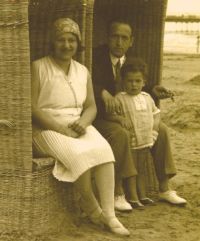
Monas-Mogroby family
Friederike married to the Amsterdam Benjamin Monas (only her name is spelled as Mogrobij on the Holocaust-sites). Benjamin was a diamond cutter. Frederieke and Benjamin had a son, Jacques Benjamin (1926). The last address of the family was Valckenierstraat 17a-I. Only Jacques survived. The family is mentioned in the telex by Willi Zoepf to the commander of Westerbork (16 March 1944), with the group that wasn't recognized by the Turkish authorities in Berlin and Hamburg as Turkish citizens. Already they, probably as the only ones of the 24 mentioned in the telex, have been deported by then. The parents are gassed on 11 February 1944 in Auschwitz. Jacques jumps from the train.
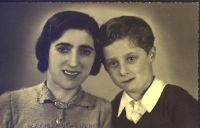
Rachel and Isaac van de Kar
Rachel married to Isidoor van de Kar from Amsterdam, typographe. They had a son Isaac Jakob (1937). Their last known address was Cornelis Anthonieszstraat 73-II in Amsterdam. None of them survived the Holocaust. This family also is in the telex by Zoepf with the group which wasn't recognized by the Turkish authorities. Mother and child are gassed on 26 March 1944 in Auschwitz. Isidoor has to work himself to death. He stays alive for a long time but dies around 9 May 1945 'in Middle-Europe'.
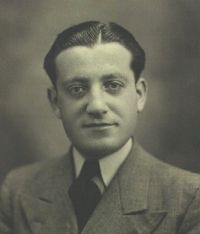
Alfred Mayer
Lea married in Arnhem to the German-Jew Alfred Mayer, who was born in London. Her husband, stateless German, was arrested in October 1942 and came through the camps Amersfoort and Vught to Auschwitz, where he was gassed on 31 May 1944. At that time Lea was expecting Robert (December 1942). Lea didn't have any documents valid to the Germans and therefore in fact also stateless. Thus is mentioned on the German 'passport-list' of 16 February 1943, on which she is the only one mentioned from the family. Her address is Van Pallandtstraat 8. Rob Mayer says his mother and he were in hiding for some time and were in fact saved by the attack of the allies on Arnhem, the operation 'Market Garden' from September 1944.
With special thanks to Rob Mayer, March 2005
All pictures Mogroby family: Rob Mayer
With thanks for the information on the last transport from Westerbork and Camp Liebau to Lucas Bruijn, January 2012
IV. Other family names and backgrounds

Panorama of Jerusalem (Bonfils, around 1800)
In 1941 about 8,000 foreign Jews lived in Holland, with 45 nationalities (apart from the 40,000 Jews from Germany). Among them was a small group of Turkish-Jews. The information the below will show it was a group of about ninety people. Presser recounts in the 'De Ondergang' ('The Down Fall', Dr. J. Presser. The persecution and destruction of the Dutch-Jewish people 1940-1945. The Hague 1965, p. 426-427 - The reference is in Ad van den Noort, Allochtonen van nu & de oorlog van toen [Nowadays immigrants & latterday war], p.60.) the following:
"Until 1945 Turkey wasn't at war with nazi-Germany. Therefore Turkish-Jews were in a 'special position' for some time. No deportation to the gas chambers. From 1 Januari 1943 this special treatment was lifted by Berlin in a letter to Ankara. This was dangerous. People who hadn't been in Turkey for five years or more, could loose their Turkish nationality according to a Turkish law and therefore be viewed by the nazi's as 'stateless'. But there were other ways to loose ones citizenship. Jews who were made stateless could be deported. Throughout 1943 and also in 1944 there is a correspondence between the German authorities about their fate."
In the correspondence is also a letter by Adolf Eichmann, the main German organisor from the extermination of the Jews. He writes that Jews with a neutral pass can't be 'abgeschoben', deported. If it is known though that Jews try to obtain such a pass, then no 'Rücksicht', no mercy, will be shown. These kind of people will be moved 'bevorzugt nach dem Osten', with priority to the East (NIOD, folder with correspondence on foreign Jews (1943)).
1. Two lists with names in February 1943
In the archives of the NIOD are some lists from early 1943 with names from Jews from neutral states, especially those with the Turkish nationality. On 11 Februari the 'Zentralstelle für jüdische Auswanderung' (Central administration for Jewish emigration) in the Amsterdam Euterpestraat sends 'on request by telephone' a list with foreign Jews to Mrs. Slottke of the Sicherheitspolizei (Security Police) and the SD (Security Service) (Referat IV B 4) in The Hague. According to Presser she did 'the book-keeping of the exemptions of deportation' and often showed up in Westerbork (o.c.II, p.163). Professor J. Houwaard ten Cate also mentions her in a lecture about the 'writing table murderer' Willi Zoepf, head of the Dutch 'Judenreferat'. Zoepf had as much work done as possible by his subordinates, among them the ladies Gertrud Slottke and Margarethe Frielingsdorf (www.aup.nl - 'The name of the crime and the person of the writing desk murderer'. Lecutre 8 May 2003 by Johannes Houwink ten Cate). On the list sent to the Judenreferat are, apart from a few Argentinian, Danish, Italian, Spanish an Swedish people, 35 names of Jews with a Turkish nationality living in Holland.
35 names
It concerns 10 addressess in Amsterdam with the families or persons Alboukerk (Benescai), Alyon (-Hatem), Bardovic, Behar (-Bechouchee, -Kuzi), Cohen (-Adjunan), Cohen (-Engelsman), Cohen (-Jerusalmi), Eskenasy (-Capuano), Jerusalmi (-Albalah, -Salah), Lichtenstein, Mizrahy, Bechouche; 2 addressess in The Hague: the households Bedak (-Petenbaum) and Amar, 1 in Haarlem: Capuano, Hatem, and 1 in Enschede: Perez (-Behar). The are mainly 'Sefardic' names.
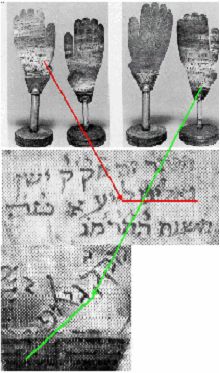
Gallipoli (Hebrew)
43 names
They don't seem to be satisfied. Also the Auswärtige Amt (Foreign Affairs) demands a list with foreign passport holders. It arrives five days later, dated 16 February 1943. While the international enumeration of 11 February accounted for 53 names, this list provides 77 namen. 43 of them are holders of a, presumably, Turkish passport. 27 were already known, 16 names are new. Almost all family names return, sometimes with new family members, like children (8), sometimes without specific members. Often in a different spelling, like Benyacai, Bardovic, Ruzi, Yerusalmy. New is the Johai-Varon family from Gallipoli, living in Amsterdam, at the Nassaukade (5) - one of them, Robert Johai (Gallipoli, 11 March 1905) had just died on 1 December 1942. The name actually is Yohaï; in Turkish also Yohay and Yohai.
Other new persons, individuals, have the name Benezra; he went in 1941 from The Hague to France - Monachimoff-Rikofski from Heemstede, Mayer Mogroby from Arnhem and Neubauer from Amsterdam, all women. Places of birth are mentioned now: Istanbul/Constantinople, Adrianople (Edirne), Gallipoli, Silibri, Smyrna, towns around Istanbul: Ortaköy, Hasköy, Kuzcuncuk. But also Jerusalem, Vienna, Wiesert, Bremen, Rotterdam and Amsterdam.
Valid passport?
With the Dutch addressess also the present or non-present passports with place of issue and validity are noted. Most passports have been issued and renewed by the Turkish authorities in Hamburg and The Hague. Only two passports are renewed until after the date on the list; one is sent to Hamburg to be renewed. Two people have a Dutch passport because of their marriage. The Bedak family and Mr. Amar only have a Dutch alien passport. The Hatem couple and three single women don't have any papers at all. Like with Mrs. Hatem also the passport of one of the Yohaï children is taken in by the Turkish authorities. As for the documents the situation of this group of 41 Turkish-Jews is very diverse. Nothing is known about the papers of the 8 other people who are on the list of 8 February.
49 names
It can be assumed that the 49 people who's names are on these two lists, and hadn't left or died, formed the main group of the 'Turkish-Jews' in Holland - though many of them wouldn't have spoken Turkish. The six children born in Holland would also have spoken Dutch. From 1 Januari 1943 these Jewish civilians weren't automatically protected anymore by documents of the neutral state of Turkey. What has become of them?
Except for one - Mrs. Dora Bedak-Petenbaum - the names on these two lists aren't in the register of the War Graves Foundation (OGS). They were protected by the neutrality of Turkey.
2. Turkish-Jews in Westerbork from end 1943
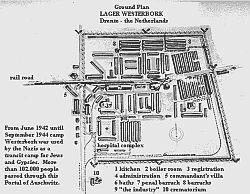
Drawing: fcit.coedu.usf.edu
Known from a camp source a 'group of Turks' is in Westerbork from the beginning of November. The diary of the journalist Philip Mechanicus about his time in the Dutch 'transit camp' Westerbork notes five times the existance of a group Turkish-Jews. On Monday 8 November 1943 he notes an 'an invasion of Turkish, Spanish, Romanian, Italian and South-American Jews from Amsterdam'. The adults speak to the Dutch inhabitants of the barrack in loud and 'chattering' Spanish and French. It's a mixed group of mediterranian Jews, many of them descendants of the Jewish population in the islamic Spain before 1492, the Sefardic. The majority of the Westerbork camp population was Askenazian, originating from German and Polish areas. In Istanbul was/is also an Askenazian community.
8 November 1943
Mechanicus is thrilled by the new neighbours, but also reacts amused. 'A small colony of Turks, parents with children, settled next to my bed: all day they live around the little stove, which they sort of monopolise because of their number, and dilligent interfere with the cooking business of others, terribly friendly and helpful. The children chatter in Dutch and in Spanish, lively, agile children, like quicksand'.
Whether is was Spanish or Ladino, the language of the Sefardic Jews in the Mediteranian, is unsure. But also Dutch was spoken, and not only by the children.
28 November 1943
In the chilly barrack, filled with three story beds, and with one decent stove, a quarrel in Dutch starts between the various groups of inhabitants. On Sunday 28 November Mechanicus notes: 'The entire day a lead gray sky, from which a nagging rain poored. The camp one peace of mud, black, black, and more black. People huddle in the barracks, their day off... A quarrel around my stove between the Turkish colony and the Dutch Jews. 'A Turk: "Shut op!" The boy: "Shut up yourself!". The woman: "Mr. Turk, you have no say in this". Another Turk, with a magnificent mustache and a cigaret between his shining teeth: "All day long we take care the cole and turf is in the stove; so we have a right to sit here".' The Turks monopolise the stove, occupy it at eight o'clock in the morning and still sit there at ten o'clock in the evening... They are dubbed the 'Dardanelles', where no one can pass; these are closed hermetically'.
19 January 1944
In the new year, on Wednesday 19 January 1944 the Turkish group moves from barrack 71 to barrack 72, 'the barrack of foreigners and double nationalities'. 'The occupants of barrack 71 are relieved the Turks have gone: a lot of noise less.' On 22 January Mechanicus notes: 'Again new quarrels about the stove, new voices, new accents, but basically exactly the same as yesterday, when the Turks were still there, who blocked the stove. A person really has to keep his nerves under control here... People can't avoid each other, they're tied with hands and feet to each other'. From a note on 3 February it seems the Turkish group is still in barrack 72, with Romanians and newly arrived Portuguese.
It isn't known who from the 49 people on the lists of Febrary 1943 ended up in Westerbork, and if so when. A letter from March 1944 speaks of 24 people; they have to be deported. A transport list from September mentions many more Turkish names; these people will be exchanged. Both times it could have been about some people in barack 72.
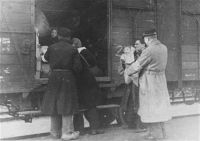
Picture: www.jewishvirtuallibrary.org
3. A telex by Zoepf
On 16 March 1944 Willi Zoepf, head of the 'Judenreferat' IVB4 and directly responsible for the transports, writes a telex to commander Gemmeker of camp Westerbork. Subject: 'Juden türkischer Staatsangehõrichkeit' (Jews with Turkish nationality). The 'Fernschreiben' (telex) contains the names of 24 Turkish-Jews in Westerbork. Zoepf orders the camp leaders to 'treat these Jews as stateless and remove them with the next transport for labour camps in the East' ('Es wird gebeten, diese Juden wie Staatenlose zu behandeln und sie mit dem nächsten Transport zum Arbeidseinsatz nach dem Osten abzuschieben') (Presser o.c. I p. 427). A copy of this letter was given by the NIOD for personal use (Feb. 2005).
Before the contents of the letter mentioned by Presser was known, it seemed likely some of the group of 49, maybe preferrable people with missing or obscure Turkish documents, would be mentioned in the letter. It also seemed likely that they would be recognised by the description from Mechanicus.
21 new names
Knowing the contents now, it is clear only three persons were also on the former lists: the couple Bedak-Petenbaum, who only had a Dutch alien passport, and Mrs. Johai [actually Yohaï], Dutch by marriage. In the telex though twice possible relatives of the group of 49 are mentioned: a family Neubauer (3) and two married women who have the maiden name Mogroby. Indeed they are sisters of Lea Mayer-Mogroby, as a relative notified (Rob Mayer, e-mail 5 March 2005).

Gallipoli (Dardanelles)
70 names
The other family names are new and often partly German and Dutch. From eight of them the places of birth are in the old Ottoman Empire (Constantinople, Gallipoli, Jerusalem, Larnaca/Cyprus and Smyrna) and Italy (Milan), with others in Germany (Berlin, Frankfurt, Cologne, Leipzig, Würzburg), Austria (Vienna), Czechoslovakia (Karlsbad), Poland (Czenstochau, Przeporsk, Warsaw) and Holland (Amsterdam - 6). The total group of people with a Turkish-Jewisch background now extends to 70 with a more Askenazian character. The telex by Zoepf also makes clear almost a third of them, especially the 'new ones', aren't protected from deportation anymore by their Turkish background.
24 unprotected
Sixteen mentioned by Zoepf, according to his telex, aren't any longer recognized by the Turkish Ambassy in Berlin or the Turkish Consulate-general in Hamburg as Turkish citizens. Eight others are deprived of their citizenship by the German council of ministers. With the first sixteen it's about members of the families Bedak-Petenbaum (2), Cymbalist-Peres (3), Friedmann-Pipesberg (3), Goldberg (1), van de Kar-Mogroby (3), Monas-Mogroby (3) and Moreno-Peres (1). With the group of eight are the family names Johay [actually Yohaï] (1), Neubauer-Dym (3) and Sorias-Benadereth (4). Isaak van de Kar (1931), named in the telex, is the same person as Isaac Jakob van de Kar (1937).
15 victims
Fifteen of the 24, sometimes with difference or mistakes in the spelling, can be found in the register of the War Graves Foundation (www.ogs.nl). The differences with OGS are mentioned between brackets. Presumably the other nine persons survived the Holocaust.
4. Deportations to Auschwitz and Bergen-Belsen
Eleven of the 24 persons mentioned by Zoepf are dead before September 1944, some of them even before he mentions them on 16 March 1943. They are nine women and two men. In paragraph II they are described in detail; below globally:
- The couple Benjamin Monas and Frei[ie]derika Monas-Mogrobij[y] already dies before the telex by Zoepf, on 11 February 1944.
- The women Dora Bedak-Petenbaum and Esther Me[o]reno-Peres, the mothers and children Rachel and Isaac Jakob van de Kar-Mogroby and Sara Sorais [Sorias]-Benadereth and her son Alberto (daughter Carmen probably not) all die in Auschwitz, during the days 25-27 March 1944. Indeed they were in the first transport after the telex, on Tuesday 22 March.
- Luna Cymbalist-Peres, her husband Szymon [Simon] Cymbalist and Abraham Goldberg die on or about August 1944. Maybe they were also part of the transport of 22 March, but not immediately selected for the gas chambers.
- At least three victims were transported to the 'more favourable' camp Bergen-Belsen: Jecheskel Josna Neubauer, his father Jakob Neubauer and Max Frieman[n]
- Isido[o]r van de Kar died in Middle-Europe.
Four more persons with the name Mogroby appear in the register of the War Graves Foundation (see paragraphes I-III). Their names are not in the telex from 17 March, but are on the transport list for the last train from Westerbork to Auschwitz, on 3 September 1944. Zillia Mogroby-Jacobi was also in this transport. She was the only one to survive from the other four family members.
Presser pupil
With the 24 persons from the telex there probably was a student of Presser, who was a teacher at the Vossius high school and later at the Jewish high school in Amsterdam. The boy and his parent(s) were killed (Presser o.c. I. p. 427. Also see: www.dbnl.org/tekst). Up to now it is not known who the student was. From the above could be derived it could have been Josua Neubauer, who's mother survived the Holocaust.
5. Exchange transport to Bergen-Belsen
From other material 44 Turkish Jews in Westerbork are known. Victor Laurentius, post-war aftercare treater of the Dutch Red Cross, writes about them in a letter to Multiple Choice (19 October 2004): Research in our archives revealed a group of 44 so-called Turkish Jews were put on transport on 13 September 1944 from the Jews transit camp Westerbork to concentration camp Bergen-Belsen. Because they were Jews with the Turkish nationality the had a special status. Because of this they were considerated for an 'Austausch' (exchange). Despite this special status the Turkish Jews in camp Westerbork weren't housed in the same barrack.'
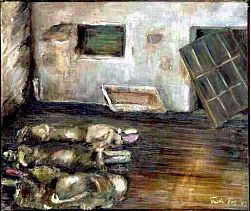
Bergen-Belsen, F.Tas (coll. JHM)
44 Turkish Jews
It is sure this group of 44 people had a - as faced by the Germans - valid Turkish nationality. Bergen-Belsen was a special destination. Though it only concerned a small part of the Jews being held there, from Bergen-Belsen exchanges were made between Jews, with a double nationality or with documents from Palestine, for Germans who were made prisoner of war by the allies.
The Turkish group came from different barracks. It is possible some people of the group which arrived on 8 November 1943 and stayed in barrack 71 and 72, had valid Turkish identity documents and were with the 44 who went to Bergen-Belsen. It is also possible some of them have been transported later to Westerbork.
Familiar names
Also the NIOD has the transport list of 13 September 1944 at its disposal (NIOD, map with transport list Westerbork 13 Sept. 1944). In total 279 persons from the camp went to Bergen-Belsen, in 7 groups. Among them the 'Diamaond list' and the 50 'unknown children'. 43 of them are Turkish and 1 probably Turkish. In comparison to the lists of Februari 1943 only 23 persons from the group of 49 are in this transport. Three of this main group are metioned in the telex by Zoepf. The 23 others probably never were in Westerbork or didn't fall into this priviledged transport (according to Presser one Turkish man lived to see the liberation of Westerbork), or have been deported before and survived.
Missing
Some known names are missing on this transport list. Though the spelling sometimes is way off or incorrect - Behar is also Becher, Recouchee is also Becouche - the following families and persons aren't mentioned: Alyon (-Hatem)(3), Amar (1), Bardovic (1), Capuano (1), Lichtenstein (1), Mizrahy (1), Yerusalmy-Salak (1), members of the family Eskenazy (-Capuano)(3), of the family Cohen-Yerusalmy (1) and of the Johai [actually Yohaï] family (2). Also three single women without documents aren't on the list. (About them, see this paragraphe nr. 6-7)
18 new names
A number of relatives, especially husbands and children, of the families Cohen/Kohen (-Souss)(2), Eskenas[z]y[i] (-Visschraper)(3), are added. Also eleven completely new Turkish-Jewish names are on the list. They are the families or persons with the name Alschech (-Waltersdorf)(2), Chichou (1), Ciaves (1), Fikri Mundij-Roos (1), Foerder-Austerlitz (1), Malalel (-Norden)(2) and Pardovitch (-Gompers)(3).
From Mietje Malalel-Norden (The Hague, 14 June 1882) and her daughter Rozette Victoria (The Hague, 13 March 1928) is known they were arrested in June 1944. The came via the Scheveningen prison, dubbed the 'Oranjehotel' (Hotel of Orange), and camp Vught to Westerbork (e-mail 18 July 2005 Hans de Vries, NIOD). Father and son Malalel were only arrested in 1945 - see below.
88 Turkish Jews
With these eighteen new names the total number of people indicated by the nazi's as with a Turkish-Jewish background for the war period in Holland is 88. Almost half of them were in the exchange transport on 13 September 1944 to Bergen-Belsen. According to Sam Behar, Albert Bechouche (pronounce 'Beshoushe') was considered to be the leader of the group.
The summing up also mentions professions. Apart from merchant, manufacturer, shoemaker, tailor, needlewoman and student, are 'tobacco cutter', 'carpet repair man', and 'carpet darner' remarkable.
The transport of the 44
As Sam Behar recalls, the 44 first were housed in the Albala part of Bergen-Belsen. After that they, except for Ribca Chichou (see paragraph I), they ended up in a 'more favourable' part of the camp, the 'Benadon' Lager. 'It comprised of two barracks and was also called the 'Neutrals Lager', because Jews from neutral countries were housed here (Spain, Portugal, Argentinia, Turkey). Midst 1944 there were about 250 Jews, March 1945 about 365. The camp owned the nickname 'Benadon' to the camp eldest (since June 1944), the Spanish Athen Benadon.' (Red Cross). There was no forced labour. Sanitary facilities and food was better than in the rest of the camp and people were seldom ill-treated. Despite this on 8 November 1944 Irma Foerder-Austerlitz died, born on 17 April 1880 in Oberglogau, a town in Upper-Silezia, at that time belonging to the German Empire (see paragraph I).
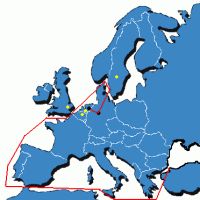
Exchange
Indeed half a year later the '44-group', without Irma Foerder, and without Ribca Chichou (see paragraph I), were exchanged. This happened despite the fact Turkey lifted its neutrality on 23 February and declared war to Germany on the first of March. The agreement on the complicated exchange though, dated from 31 January 1945, and was achieved by the German ministery of war and the British embassy in Ankara. 'On 4 March 1945 a group of 105 Turkish Jews, among them the Turkish Jews from Holland, where brought to Turkey as part of an exchange transport. The journey first went to Sweden and from there with the steamer 'Drottningholm' to Turkey' (Red Cross). The 'repatriation programme' was set up by the German Ministry of Foreign Affairs, and also brought 365 Spanish and 19 Portuguese Jews from Bergen-Belsen to their country of origin. (For the names of the passengers from Holland see this paragraph nr. 6)
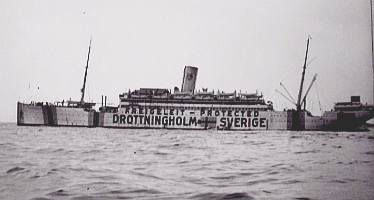
Mercy Ship Drottningholm (picture: salship.se/mercy.asp)
SS Drottningholm
The 'Drottningholm' (1904, as 'Virginia') and the cruiseship the 'Gripsholm' (1925) were especially used for these kind of exchanges. Both ships were owned by the Swedish-American Line (SAL) and were chartered by governments after negotiations by the Red Cross. They were called Mercy Ships. During the war the ss Drottningholm made 14 voyages for the exchange of diplomats, prisoners of war and Jews with passports from neutral countries. The ship was painted with texts like 'Protected' and 'Freigeleit' (safeguard) and flied the Swedish flag. It had to evade mines on its own.
Eyewitness
According to officer Carl-Otto Claesson (www.salship.se/claesson/prisoners.asp) nazi-Germany wanted to exchange diplomats and civilians who were interned in Lebanon and Turkey, for Argentinian and Turkish passport holders in Germany. The English ambassador in Turkey, on behalf of his government, agreed if at the same time British would be exchanged for Germans. Claesson writes the ship had 350 persons on board with a British passport, among them 60 seriously ill, 130 Swedes, 115 persons with an Argentinian passport, about 30 with the Portuguese and Peruvian nationality and 325 Turks. Eighty of them wered from the Turkish embassy in Berlin. He doesn't mention any Jews with Turkish, British, Argentinian or Portuguese documents. Free
The Drottningholm left on 15 March from Gothenburg, made a stop over in Liverpool and also visited other harbours. In Port Saïd Mercado Yohaï was buried; one of the about fourty Turkish Jews from Holland. In Izmir the mother of Izak Chaves stood waiting in vain for her son. Final destination was 'Constantinople', Istanbul. There the last Turkish Jews went ashore.
Apparently many of the 42 survivers of the repatriated group were that much rooted in Holland they didn't stay in Turkey. Partly this was because of some Turkish-Dutch marriages. The Red Cross writes: "As far as I could gather, at least 23 Turkish Jews returned from Turkey to Holland after the war". Passenger Sam Behar remembers that a family returned from Istanbul on 16 July 1946. They were, like many returned Jews, housed in the Amsterdam Weesperstraat, in the 'Joodse invalide'.
Stayed
It is likely some of the 21 persons who weren't on the transport list of 13 September 1944 nor on the telex of 17 March 1944, stayed in Holland. This also applies to the (8) survivors ot the group mentioned by Zoepf. (see this paragraph, nr. 7)
Liberation of Westerbork
Presser names the nationalities of the on 15 April 1945 in Westerbork still present persons (see Ondergang part II, p. 365); this was the day on which the Canadian troops liberated the camp. From the 876 men, women and children, one man has the Turkish nationality.
From research by the NIOD (Hans de Vries, see above) it appears he was Habibe Malalel (Constantinople, 15 May 1892), husband of Mietje Malalel-Norden. Also their son Robert (The Hague, 13 June 1923) was one of the 876. Mietje and her daughter were passengers on the Drottningholm (see summary of the 44-group).
80% survivors
Seventy of the 88 Jewish citizens who possessed Turkish papers (acknowledged by the German and Turkish authorities) survived Hitlers genocide. The total group of Ottoman origine as well as the number of victims is much larger though, as can be derived from the names of those who were born in the Ottoman Empire (paragraph II), the information about the Mogroby family (paragraph III), and from stories about the passengers on the Drottningholm and other survivors (see nr. 6-7).
6. Passengers of the ss Drottningholm (March - April 1945)
The names of the 44 Turkish Jews who probably were aboard the 'Mercy Ship' Drottningholm, are derived from the transport list of the train that drove on 13 September 1944 from Westerbork to Bergen-Belsen (see above). The numbers are in agreement with this summary on which are, as well as Turkish Jews, also other nationalities. These are mentioned in a PS. Many Turkish names are also mentioned in other documents discussed here. Personal information about the group, their family members and small differences between the transport list and the actual passengers, is given by Sam Behar (1932), one of the children aboard. Sam worked/studied from his 16th year and helped, as a Jewish teacher, social worker, army rabbi and pastoral worker, with the rebuilding of the Jewish community. In July 2005 he emigrated to Israel. Two of his children live in Holland, two others in Israel. Other details are given by several relatives, who are mentioned with the families concerned.
Spelling
The spelling of the names is complicated. Originally the names were in Arabic writing, which was common in the Ottoman Empire and Turkey until in the twenties of the 20th century. Converting them to the Latin writing happened according to Turkish, French, Dutch and German principles. Albukerk or Alboukerk; Luna or Louna; Becouche or Becouchee; Benescai, Benyacai or Benyagai; Cohen or Kohen; Yohai/Johai/Yohay/Yohaï. Also mistakes were easily made: Recouchee for Becouchee.
Alboukerk-Benescai/Benyacai (nr. 1-3)
Mi-Chon (Maurits/Moïse) Alb(o)ukerk (Stamboul-Ortakõy, 4 August 1901) and Rebecca (Refka) Alb(o)ukerk-Benescai/Benyacai/Benyagai (Istanbul-Haskõy, 10 April 1896) are on three German documents: the list of the Zentralstelle (11 February 1943), the passport list (16 February 1943) and the Westerbork transport list (13 September 1944) - in varying spelling. The name of their daughter Louna (Fanny) (Amsterdam, 22 April 1934) isn't on the list of the Zentralstelle.
JulY 1931 the parents came from Istanbul ('Stamboul'), Turkey. In 1943 they lived at the Reguliersgracht 1-II in Amsterdam. The profession of Maurits Alboukerk was manufacturer. His passport was handed out on December 1941 in Hamburg and renewed for a year. Louna is her mother's passport, handed out on August 1941 in Hamburg and renewed for a year. On the date of the transport they were 43, 48 and 10 years old, respectively. Sam Behar (see below) knew Fanny Albukerk very well; they were at the same school. After the war the family returned to Holland. Rebecca died before her husband died. Both are buried in the Portuguese-Jewish cemetery at Ouderkerk. Fanny went to America.
Alschech-Waltersdorf (4-5)
Flora Alschech-Waltersdorf (30 December 1875) and Camilla Alschech (5 December 1897) are only mentioned on the transport list for Bergen-Belsen; presumably they are the widow and daughter of the Turkish-Jewish man Moriz Alschech (Vienna, 1862). At the start of the transport they were 68 and 46 years of age, respectively.
Becouché[e]-Behar (6-8)
Avram (Albert) Becouche[e] (3 March 1893), carpet repairman, and Rosa (Roza) Becouche[e]-Behar (also written as Becher)(3 February 1898), with Fortuné (Fortuna) (15 August 1922). They aren't mentioned on the passport list; because of this their place of birth is unknown. The family name is written as Recouché on the list of the Zentralstelle.
They lived at Amstel 113, Amsterdam, below the family of Salamon ('Max') and Dudu Behar-Kuzi. Sam Behar writes Roza was his aunt, probably a sister of his father Salamon, and that Albert was his 'onkie' ('uncie'). Albert Bechouche (pronounced as Beshoushe), was 'leader of the group of Turkish Jews' of the 13 September transport and 'a real Levantine, a true hedonist'. He also was the contact for mrs. Slottke of the German Referat IVB4. On the day of the transport they were 51, 46 and 22 years old, respectively. The family returned to Holland. Fortuné Bechouche married the liberal Jewish Hans Naarden. They had a daughter, a son and grandchildren. Fortuna died in 2004, after her husband, and was buried in Hoofddorp.
Behar div. Perez (9-10, 52)
The family Behar div. Perez is in all three documents. The mother is called Bellina Behar (Silivri, 10 October 1907), divorced Perez. Silivri is 20 km west of Istanbul. On her passport, renewed in Hamburg until August 1943, there are two children: Mario Jakob Perez (Rotterdam, 23 October 1927) and Luisa (Loesje) Perez (Amsterdam, 4 July 1930).
In February 1943 the mother and children lived in Enschede, Emmastraat 229. Mario is named separately at the transport list, as 'student'. At that time their age was 37, 17 and 14, respectively. They returned to Holland and later on emigrated to Israel. Mario died because of an accident. The family isn't related to the family below; the name Behar is quite common in the Sephardic world.
Behar-Behar (11)
The name of Perla Behar-Behar (21 March 1872) isn't on the passport list, but is mentioned in the other documents. She is registered at the Amsterdam address Amstel 113. Here also lived Roza Bechouche-Behar (see above) as well as Salamon Behar (see below), probably her children. Sam Behar doesn't mention her name.
Behar-Kuzi (12-16)
Salomon (Salamon, 'Max') Behar (Adrianople/Edirne, 10 November 1903) and Dudu Behar-Kuzi (ditto, 10 January 1900-1970), with Suzanna (Amsterdam, 27 February 1931-Orléans 1997), Samuel (Sam) (ditto, 9 December 1932) and Israel (ditto, 23 September 1934-1993). The names of the parents - Kuzi is also written as 'Ruzi' - is in all three documents; the children aren't mentioned on the list of the Zentralstelle.
On 20 January 1930 the family is registered from Constantinople in Amsterdam. Sam Behar tells, his parents had to work very hard to make a living in Holland. They were in close contact with compatriots. Aunt Bella Yerusalmi who lived in Amsterdam at the Nieuwe Achtergracht, walked little Sam around in a pram. In February 1943 the family lived at the same address as the Becouche-Behar family (see above). The parents Behar had a Turkish passport dated 10 November 1941, renewed until 11 October 1942, handed out by the Turkish consulate in Hamburg. The fathers profession is mentioned as 'Tabakschneider (tobacco cutter). The children are in their mothers passport. In September 1944 their ages were 40, 44, 13, 11 and 10, respectively.
The family survived thanks to their Turkish papers, as many of this group did. The 'nüfus', Turkish identity card, from Israel Behar was stolen by one of the fellow travellers. This person wasn't in the transport. Sam tells they were first in the Albala Lager and later on in the Benadon Lager in Bergen-Belsen - the Albala camp is unknown. On 4 March 1945 the group travelled by train to Sweden and from there on went with the Drottningholm to Izmir, Turkey (see introduction). On 16 July 1946 the family Behar-Kuzi returned from Istanbul to Holland. For the second time they had to start from scratch. Sam tells it was almost too much for his mother; she was dead beat when she returned from the war.
Robert Yohaï tells about Max Behar, being a very nice man, 'but that deaf, that when I visited him I had to pull a rope outside, which made a real bell with clapper rant and rave, resulting him hanging out of the window to see who was there (e-mail 14 January 2009). The parents and brother of Sam Behar are buried in Ouderkerk.
Chichou (17) - not aboard
Ribca Chichou (Safed/Palestine, 23 June 1892). Her name is only on the transport list. Behind her name is 'wahrscheinlich Türkei' (probably Turkey) and 'straffällig' (punishable) (been in hiding?). She wasn't housed in the Benadon camp and wasn't part of the exchange. Mrs Chichou died because of the evacuation of Bergen-Belsen. Also see paragraph I.
Ciaves/Chaves (18) - not aboard
Isaac (Izak) Ciaves/Chaves (20 December 1914) is also at the list of 13 September 1944, profession tailor. According to Sam Behar, who writes 'Chaves', Izak didn't go with the transport though. Before he lived some time with the Behar family. On the arrival of the Swedish ship with Turkish Jews from Bergen-Belsen Izak's mother waited for him in vain in Izmir.
Cohen-Yerusalmi (19-20, 22)
Avraam (Awram) Cohen (Constantinople, 15 November 1896), merchant, and Esther Cohen-Yerusalmi (Jerusalmi)(ditto, 2 June 1888) are on all three lists. This isn't so for the children Bohor (Robert) (ditto, 19 February 1923), but is for Fanny (Amsterdam, 18 July 1927).
According to the date of birth of Fanny the parents and their first child will have come to Holland between 1923 and 1927. Avraam was a son of Esther Cohen-Adjiman (nr. 21) and the older brother of Zaffira (nr. 25) and Isaac (nr. 43). Esther was probably related to the family of Louna and Isak Yerusalmi (nr. 39-40). In 1943 the Cohen-Yerusalmi family was registered at the Nieuwe Keizersgracht 1-c in Amsterdam. They had a Turkish family passport, handed out in The Hague and valid until the end of August 1941. One the day the left the family members were 47, 56, 21 and 17 years of age, respectively. The parents and Fanny survived with the Turkish group of Bergen-Belsen, Robert survived in Holland. Avraam, Esther and their daughter returned. Fanny married Ab Ryxman. Except for Robert all were buried in the Ouderkerk cemetery.
Cohen-Adjiman (21)
The name of Esther Cohen-Adjiman/Adjunan (Stamboul, 13 November 1873) is in all three lists. The lists from 1943 spell her family name as Adjunan. Her Turkish pass is handed out in 1938 in The Hague and renewed until May 1940. She lived at the Nieuwe Achtergracht 55-III, With her children Zaffira and Isaac (see nr. 25 and 43). Her son Avraam lived elsewhere with his family (see nr. 19-20). On the day of the transport she was 70. Sam Behar writes Esther Cohen-Adjiman was a very sweet woman and a good friend of his mother, Dudu Behar-Kuzi. After the war she returned to Holland and after her death she was buried in the Ouderkerk cemetery.
Cohen-Souss (Kohen-Souss) (43-44) - with an extra passenger
Isaac (Jacques) Cohen (Kohen) (Istanbul, 29 March 1902) and his wife Rachel Souss (22 June 1917) are both on the transport list; he with the name Kohen. Only Isaac is also mentioned in the two other documents, living at the Nieuwe Achtergracht 55, with his mother Esther Cohen-Adjiman (nr. 21) and his sister Zaffira Engelsman-Cohen (nr. 25). Also Juada Mizrahy (Istanbul, 26 May 1912), who's name is on the list of the Zentralstelle, lives here. He only had papers valid for the year 1935. The profession of Isaac Cohen is 'merchant'. His Turkish pass from March 1939, The Hague, is renewed for another year. Tico Hattem also knows a Leon Mizrahi, who was a friend of his father and went into hiding in at his place in the Beethovenstraat.
Sam Behar tells Isaac was very hard of hearing. He also writes that their child, Victor, was born in Westerbork; the boy isn't on the transport list of the NIOD, his niece Hortense (1942) is. 'He was everyone's baby. Together we made 'cream' for him, by whipping potatoes. On the day of departure the parents were 42 and 27 years of age, respectively. They returned from Turkey to Holland. Already soon after the war Rachel died. Isaac remarried to Gentile Adato. Both are buried in the Ouderkerk cemetery.
Engelsman-Cohen (24-26)
Jacques Engelsman (8 January 1917) and Zaf(f)ira (Zafiera) Engelsman-Cohen (Constantinople, 29 December 1905) are on all three German documents. Their address is the same as from Zaffira's mother (nr. 21) and her brother Isaac (nr. 43): Nieuwe Achtergracht 55-III in Amsterdam.
By her marriage to Jacques Engelsman Zaffira obtained the Dutch nationality (29 July 1942). Jacques profession was 'Kontorist', office clerk, her profession 'Näherin', seamster. Their daughter Hortense was born on 30 December 1942. The year-and-a-half year old girl is also on the transport list. Despite her recent Dutch naturalization Zaffira somehow managed to obtain life-saving Turkish papers. On the day of transport Jacques and Zaffira were 27 and 38, respectively. After the transport to Bergen-Belsen, Sweden and Turkey they returned to Holland. After her death Zaffira wasn't buried in Ouderkerk but at the Jewish cemetery in Amersfoort; for some time there she was treated by the Sinaï Center.
Eskenazi (27, 30)
The names of Samuel Eskenazi (26 October 1885), carpet darner, and his daughter Bellina Eskenazi (29 January 1913), carpet darner, are only on the transport list. At that time they ware 58 and 31 years old. Sam Behar confirms they were in Bergen-Belsen. Bellina was married to one of the sons (Daud or Maud) of Kalef Perez. After the war they went to the United States.
The digital Jewish Monument (www.joodsmonument.nl) knows three persons with the name Eskenazi. Samuel Alexander Eskenazi was born on 16 July 1943 in Westerbork, and died there three weeks later (6 August). At that time his father, Albert Eskenazi, (Vienna, 6 September 1914) was already murdered in Auschwitz (23 July). His mother, Keetje van Rijs (The Hague, 11 December 1913), seamster, died on 30 November 1943 in Auschwitz. The young couple lived at the Gouverneurlaan 161 in The Hague. It is likely Albert, born in Vienna, was the son of Samuel Eskenazi, and lived with his wife with him and Bellina. Presumably the young couple had no acknowledged Turkish papers. The Jewish Monument writes also the mother of Albert, the wife of Samuel Eskenazi, survived. Maybe she also was aboard the ss Drottningholm. Samuel probably was related to Maurice Eskenasi; the name probably is another transcription of the Turkish name still in Arabic writing.
Eskenasy-Capuano (-Vischschraper) (28-29, 31) - with an extra passenger
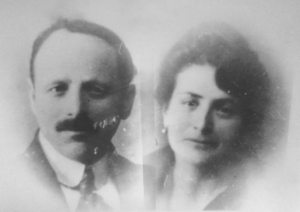
Moïs and Refka Eskenasy-Capuano, around 1930. (coll. Jacqueline Eskinasi)
Addresses in Amsterdam, Haarlem and Arnhem
Maurice (Moïs) Eskenasy (Constantinople, 13 October 1884 - 11 November 1950) was married to Rebecca (Refka or Rifka) Capuano (4 March 1887 - 11 March 1956) - in her Turkish passport of 1956 her name is Eskenazi and her year of birth is 1886. At that time she lives at Churchilllaan 8 in Amsterdam. Refka was a sister of Fani Hatem-Capuano, the mother of Albert Hatem and Meri Alyon-Hatem. Maurice was a merchant. In 1927 he is the one who receives the young Albert Hatem when he arrives in Amsterdam. There were two sons: Isaac (Jacques) (Constantinople, 4 September 1918) and David (Vienna, 12 March 1923). The family Eskenasy had Vienna as a stop-over, just like the families Eskenazi and Mogroby. On the passport list only the father and the two sons are mentioned; Maurice and David have a passport from Hamburg, renewed until October 1942, Jacques from The Hague, valid until Augustus 1941.
On the list of the Zentralstelle are the names of the parents, from Jacques and from an E. Eskenasy-Capuano (4 March 1893) - she probably is Refka with misspelling the initial and year of birth.
In the early forties the family lived in the Geuzenstraat 82 in Amsterdam. During the war David married Sara (Lientje) Vischschraper (29 May 1925); it was a 'verstandshuwelijk, bedoeld om haar door de oorlog te slepen' [a marriage of convenience to get her through the war]. The transport list to Bergen-Belsen only has the names of the parents and their daughter-in-law Lientje. They were 59, 57 and 19 years old, respectively. The names of Jacques and David (at that time 26 and 21) are missing.
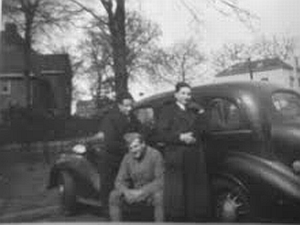
Jacques (Isak) Eskenasy with brother David and cousin Albert (in uniform) with his Dodge, around 1939. (coll. Jacqueline Eskinasi)
Addresses in Amsterdam, Haarlem and Arnhem
Jacques Eskenasy (later Eskenazi) went into hiding in the Beethovenstraat with Albert Hatem with five more persons, where he survived. It is also sure David was not in the transport. He came to Istanbul via France. After the liberation David and Lientje divorced as had been agreed. David married Nora Gazan and changed the family name into Skenazi. The couple had two daughters: Evelyne (1951) and Pauline (1954), and, from a new marriage with Johanna Zwaan, three sons: André (1958), Rudolph (1961) and Arthur (1964). David passed away on 28 April 2009 in Kortrijk (Belgium). Jacques died in 1991 in Alicante (Spain) - more information is to be found in paragraph 7. Other survivors.
With thanks to mr. André Skenazi (Brussels, July 2009, August 2013), mrs. Jacqueline Eskenasi (August 2013) and mr. Tico Hattem (Amsterdam, September 2012).
Fikri (Bey) Mundij-Roos (32)
Maria Fikri (Bey) Mundij-Roos (5 October 1882). Her name is only in the transport list. The Jewish Monument knows Maria as an interpreter, living at the Rijnstraat 10 in The Hague. The Monument presumes she died, but doesn't know a date or place of death.
From a Fikri 'Bey' (sir) Mundij (Münci) is known that he served as consul-general to the Ottoman Empire; he also was a literary man. It is very likely he was the husband of Maria Roos. He will have been born around 1869. In 1892 his son Feridun Fikri Düsünsel was born (www.atam.gov.tr) - he became a well-known Turkish lawyer and member of parliament.
New York
On 20 August 1899 the New York Times published an interview together with a photo of Fikri Bey. At that time Mundji was thirty years old and since a year and a half the sultan's representative in USA. His fluency in English is praised by the newspaper. Fikri Bey is also fluent in some other languages the journalist adds. His father, H. Fikri Pasha, was governor of a few Ottoman provinces. Since 1887 Fikri Bey was in the sultan's service. Before his position in New York, he worked three years as a consul in Greece. He wrote books with titles as 'The bitterness of life', 'Flight to death' and 'The pink handkerchief', in which a personal romance was worked into.
British Empire
From a note on the site of the English National Archives (1916) it appears that Fikri Mundji had also the position of consul-general in the British Empire. He asked to have his personal belongings sent over to Amsterdam (www.nationalarchives.gov.uk/catalogue/displaycataloguedetails). In January 1916 the battle of the Dardanelles ('Gallipoli') ended, in which the English and their allies in vain tried to get hold of the entrance to Istanbul. Turkey was on the side of Germany and Austria. Probably because of the hostile relations the Turkish diplomat was extradited.
The Netherlands
It is likely that mr. Mundji stayed for a longer period of time in Holland, possibly also because of diplomatic work in The Hague. In the passport list are as well a Turkish embassy as a consulate in The Hague. Fikri Bey Mundji's date and place of death aren't known either.
Foerder-Austerlitz (33) - not aboard
Irma Foerder-Austerlitz (Oberglogau, 17 April 1888 - ogs.nl has as only site 1880). Her name is only on the transport list. Irma Foerder was, together with Ribca Chichou (see nr. 17) the only two of the transport who didn't survive the Holocaust. She died in Bergen-Belsen, on 8 November 1944, probably in the Benadon-Lager, within two months of arrival, 56 years of age (also see paragraph I, victims).
Malalel-Norden (47-48)
Mietje Malalel-Norden (14 June 1882) and her daughter Rozette V. Malalel (The Hague, 13 March 1928) are only mentioned on the transport list. The husband of Mietje was Habibe Malalel (Constantinople, 15 May 1892). His profession was, according to a genealogic site, carpet weaver; her profession was seamster. The parents of Habibe were Avram Malalel and Vida Eskenazi. Son Robert (The Hague, 13 June 1923) was arrested together with his father Habibe in January 1945 and brought to Westerbork, where they stayed until the liberation. Already in September 1944 mrs. Malalel had been deported to Bergen-Belsen together with her daughter Rozette. Mother and children seemed to have been protected by the Turkish nationality of the father. Mietje and Rozette were at the moment of departure 62 and 24 years old, respectively. They returned to Holland unharmed.
Pardovitch-Gompers (49-51)
The names of Yussef ('Yassef', 'Joseph') Pardovitch (16 January 1899), merchant, Hendrika Pardovitch-Gompers (Amsterdam, 22 July 1905) and Vladimir ('Wladimir Yassef', Amsterdam, 5 February 1930) are only mentioned in the transport list. At departure to Bergen-Belsen they were 45, 39 and 14 years old, respectively. Sam Behar only remembers the name of the family.
From information on the Jewish Monument it appears that in 1941 the couple lived together with the parents of Hendrika at the Volkerakstraat 35-I in Amsterdam. For Wladimir is was a five minute's walk to the Dongeschool at the Dintelstraat (nr. 5). The head master was mister Zandvoort. In September 1941 Wladimir was not allowed to attend school there anymore. His grandmother, Johanna Levie Gompers-van Berg (Groningen, 1873) died before the deportations started, on 28 February 1941. There is a picture of her during the wedding of Hendrika and Yussef. Their marriage was in 1929.
Hendrika's sister, Henriëtte (Amsterdam, 1907), married in 1936 to Heinz Levy (Hannover, 1904) - in 1924 a boxer at the Olympic Games in Paris, and in Amsterdam a fur trader. Hendrika's father Hartog Gompers (Amsterdam, 1874) is on a picture that was saved from this marriage.
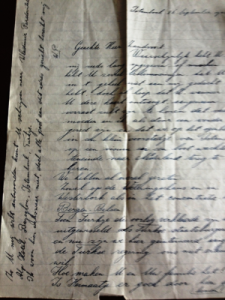
Fragment letter Pardovitch to head master (click to enlarge). Coll. Mw. Adriaansen-Timmer
The family of Reinier Herman Zandvoort (Dalen, 20-3-1894 - Zeist, 27-1-1980) kept a letter from 'Istamboul'. Wladimir Pardovitch informs his former head master about his situation and asks about the situation in The Netherlands. The Pardovitch family wants to return.
The letter opens frank: 'Probably you have given up on me for some time now, or maybe you have so much on your mind you did not think about me at all'. Wladimir is with his parents interned in a small suburb, because the Turkish government does not want to recognize them. They are waiting for visa and a boat to be able to return to the Netherlands. The Pardovitch family recounts that in 1945 Wladimir and his parents were in a kind of hotel on one of the four larger Princes' Islands, Burgaz. These islands are in the Sea of Marmara, twenty kilometers south-east of Istanbul, across the coastal towns of Maltepe and Kartal. Well-to-do people from Istanbul, among the Jews, had their summer residence on Burgaz.
Wladimir tells that the family during the war first had been detained in the Weteringschans prison, had been deported to Westerbork and from there to Bergen Belsen. So this was on 13 september 1944. 'When Turkey declared war (to Germany) we were exchanged as Turkish citizens'. He refers to the transport of 4 March 1945 to Sweden and from there with the ss Drottningholm naar to Turkey.
Wladimir asks extensively about the 'worries' of mister Zandvoort and his daughter Herma, 'Hermaatje' (5-9-1937). In the London edition of Vrij Nederland he read an interview with teacher Blok about the difficulties the teachers and child carers had to face during the last months of the war. In this connections he writes about how they have fared themselves. 'From my entire family who were deported (about 80 persons) very probably not even one survived'. They rely on messages they receive from the Netherlands. His parents are very happy that friends in Amsterdam tried to contact them, 'so at least we know there are people waiting for us'. On the side of the letter he vertically writes the postal adress to which mister Zandvoort could return a letter: Hôtel Alp in the well-know, European orientated part of Beyoglu.
That the major part of the family died in the Holocaust surely applies to the family of Wladimir's mother. Her father Hartog was deported to Sobibor, where he was gassed on 16 July 1943. Henriëtte and her daughter Yolanda were murdered in Auschwitz on 19 November that year. Heinz died four months later.
Hartog was deported to Sobibor were he was gassed on 16 July 1943. Henriëtte and her daughter Yolanda were murdered in Auschwitz, on 19 November that year. Heinz died there four months later.
On the lists from the Zentralstelle and the passports there is another Firtlis Bardocic/Bardovic (Constantinople 7 September 1897). This probably is Fritz ('Frits') Pardovitch, a brother of Yussef Pardovitch. He lived at the Tuyl van Serooskerkeweg 10 in Amsterdam.
With thanks to Mrs Adriaansen-Timmer (July 2012) who made the letter by Wladimir Pardovitch available to us, and the Pardovitch family (July 2012)
Yerusalmi-Albalah (39-40)
'Jerusalmi' in the transport list
In Februari 1943 Isak (Izak) Yerusalmi (Cumuleune (?), 13 December 1907) and Beya (Bella) Yerusalmy-Albalah (Adrianople/Edirne 20 January 1902) lived at the Nieuwe Achtergracht 22 in Amsterdam. There also lived a relative of Izak, Louna Yerusalmy (Jerusalmi)-Salah (Constantinople, 1868). Esther Cohen-Yerusalmy (Constantinople 1888), probably also related, lived at the Nieuwe Keizersgracht. Sam Behar tells, in his youth aunt Bella drove him around is the pram.
The names of Izak and Bella are on all three documents, except for Louna's, who isn't on the transport list. On the passport list the family name starts with a Y. The couple has a Turkish 'Ausweis' from Hamburg from October 1941, renewed until October 1943. Here the profession of Izak is 'shoemaker'. Louna's pass is from the Turkish consulate in The Hague, end August 1940, also renewed for a year. Louna 'Salah' died in Westerbork, on 28 February 1944 (www.drenlias.nl; the Jewish Monument gives Louna 'Jerusalmi' 25 February as date of death). There aren't any family members mentioned in the death register.
The day of transport was 13 September 1944. After the war the couple returned to Holland. Bella Yerusalmy stayed in the home for the elderly Beth Shalom until high age.
Yohaï-Varon (41-42) - with an extra passenger
'Johai' on the transport list
Mercado Yohaï (Johai) (Gallipoli, 22 November 1875), Simroja (Signora) Yohaï-Varon (Gallipoli, 12 October 1887) with Robert (ditto, 11 March 1905), Louna Fanny (ditto, 1 November 1910) and Avram (Albert) (ditto, 6 December 1911). The family lived at the Nassaukade 316. There was a family passport, handed out in August 1940 by the Turkish envoy in The Hague, and renewed for a year. Parents and children are mentioned as Johai and Johay on the passport list. Yohaï is the actual spelling. Only the parents are on the list of the transport to Bergen-Belsen. But Sam Behar writes, Fanny went also. At that time the parents were 68 and 56, Fanny was 34.
In Turkey the family lived in Gallipoli (Gelibolu). There were also relatives in the neighbouring coastal villages of Cannakale and Tekirdag. The family Yohaï came to Holland in 1923. Robert was a tobacco blender and first worked for the cigarettes company Broches & Co (a broche is a Jewish prayer). After that he started under his ow name YOHAÏ a cigarettes factory at the Ouderzijds Voorburgwal in Amsterdam. Sam Behar tells that a business associate was found, Rottenberg, so the company name became 'Yohaï & Co'. Robert married and had a son, Robert jr. He died on 1 December 1942 and is buried at the Portuguese cemetery in Ouderkerk, during the middle of the war. On his grave are the crescent and star of Turkey.
On 3 October 1935 Louna Yohaï married a Dutchman, Morpurgo, but kept her Turkish nationality. According to the telex by Willie Zoepf though (March 1944) this would have been taken away from her by the Turkish authorities. In July 1938 Albert married a non-Jewish woman, lost his Turkish nationality but didn't have to leave.
Parents and daughter lived to see the voyage from Bergen-Belsen to freedom. Mercado Yohaï though died during the sea voyage to Turkey on the ss Drottningholm and was buried in Port Saïd. After the war mother and daughter returned from Turkey to Holland. Fanny Yohaï remarried and all three emigrated to the United States.
Albert Yohaï stayed and went into hiding with his friend Albert Hat(t)em at the Beethovenstraat 62. He had a business, where Sam Behar's father worked after his return. In 1982 the Yohaï & Co Dutch Tobacco Company produced the cheapest cigarettes in Holland.
[With thanks to Robert Y. Yohaï, January 2009]
PS. On the transport list of 13 September 1944 to Bergen-Belsen are 10 more persons, with papers from other countries.
One person with the Romanian nationality (23)
Gertrud Deutsch-Meijer, 1908, steno typist
Three persons with the Hungarian nationality (34-36)
Klara Hegedüs div. Blitz, 1914, seamster.
Robert Blitz, 1940
Marcel Hegedüs, 1912, musician - Sachsenhausen 10 December 1944.
Five persons with the Argentinian nationality (37-38, 46, 53-54)
Frederico A. Hochheimer, 1909, merchant
Sitta Hochheimer-Löwenstein, 1914, optician
Jacob de Lange, 1901, manufacturer; he died in Bergen-Belsen on 3 February 1945, before the exchange
Walter Picard Baumann, 1899, merchant
Ellen Picard Baumann-Rosenthal, 1912.
One person with the Egyptian nationality (55)
Margaretha Siliava, 1911, nursery teacher, died in Tröbitz on 28 April 1945 - see paragraph II, victims
7. Other Turkish-Jewish survivors (1940-1945)
These names are from the Zentralstelle- and passport list (February 1943). These names are from persons who aren't on the Holocaust sites and aren't mentioned as a relative or member of the household in other biographic notes from paragraph I-IV. Only with the Hatem family a relation is known with the passengers of the ss Drottningholm (IV.6).
Alyon-Hatem
1-2. Muiz (Moïse, Moïs) Alyon (Kuzcuncuk, 22 March 1913) and Meri (Mari, Mary) Alyon-Hatem (Istanbul, 29 May 1914). The parents are on two German lists of February 1943, but not in the transport list for Bergen-Belsen. Moïse is mentioned as living at another Amsterdam address, 1e Helmersstraat 127, than Mary who is living at the Admiraal de Ruyterweg 32. Relatives of Meri are Fani Hatem-Capuano (Constantinople 1881) and Albert Hatem (ditto 1913), see below.
After the war the parents separated. Both are buried in Jewish cemetery at Ouderkerk aan de Amstel.
Additions by Tico Hattem (Sept. 2012): "Meri was the sister of my father Albert Hatem. At the end of the twenties, together with her second cousin Moïse and her parents, Jako and Fani Hatem, she followed Albert to Amsterdam. Muiz Alyon (also named Aelion) registered himself at the 1e Helmersstraat, Meri with her parents at the Admiraal de Ruijterweg. Having more than one address offered more security. During the war they went into hiding with Albert, mother Fani and two friends of Albert, with his girlfriend Annie in the Beethovenstraat. During the time they were in hiding, on 13 December 1943, they had a daughter, Fanny, and in 1946 a son. After the war Moïse and Meri separated. She died on 2 December 1969, he on 5 November 1974."
3. Jozef (Josef Samuel Lico) Amar (Vienna 1 September 1909). In 1943 he lived at the Stalpertstraat 64 in The Hague and had a Dutch alien passport, valid until 25 August 1940.
4. Nissim Benezra (Smyrna, 6 June 1885). He lived at Noordeinde 138 in The Hague, and was struck off the register on 13 May 1941 to France.
5-6. Hatem (Hattem)
 Albert Hatem in 1927 on the boat from Constantinople go Brindisi (coll. Tico Hattem) |
On the two lists with names of 1943 is also Albert Hatem (Istanbul, 27 August 1913). Together with Fani Hatem-Capuano (Istanbul, 21 May 1881) he lived at the Grote Houtstraat 104 - a shop at the corner of the Nieuwsteeg - in Haarlem. Behind the name of Albert it says 'no Personalausweis' (no papers). The same problem is with the name of mrs. Hatem-Capuano: 'keine Papiere'. 'The national identity card was taken from her and she can not get any new papers'. Though they were not part of the transport their name is not with the victims. Of Albert Hatem it is sure that he survived (thanks to mr. André Skenazi, July 2009). They lived at the same address as their fellow townsman Semaria (Mario) Gabay (1915). He was a carpet salesman and lived together with his Dutch wife Dina Smeer (1918) at the Grote Houtstraat 104-106. They were in Westerbork in February 1944, where their daughter Serica Bianca died (28 February 1944), 11 months old. She was allowed to be buried at the Jewish cemetery in Ouderkerk. Semaria and Dina didn't join the transport of 13 September. The couple probably already had left. Semaria probably didn't have any Turkish papers anymore. Both died, at a different time and place, in the Shoah. See paragraph II, 6-8. Additions by Tico Hattem (Sept. 2012): "Albert Hatem and Fani Hatem-Capuano (pronounce 'Fanny') went into hiding in Amsterdam. How did the Hatem family end up in the Netherlands and how did they survive the war? I would like to say the following about this: |
Around 1927 a number of young Turkish Jews, mostly from Constantinople and its surroundings, went to the Netherlands. The main reason for leaving Turkey was that, as a Jew, they did not want to serve in the Turkish army. As a minority you were at great risk, and the memories of the horrors of the First World War with the massacre at Gallipoli (1915) and the following Turkish independence war (1920-1922) was still vivid. My father was among the ones that left. Later on he was followed by his father Jako ('Jacques'), his mother Fani and his sister Mari, with her second cousin Moïs. In 1927 Albert Hatem was almost 19 years old. Before leaving Constantinople his date of birth was lowered with four years and now officially became 1913. Now his sister Mari is only 7 months younger.
 |
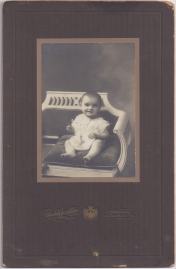 |
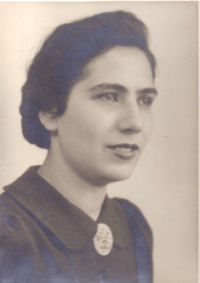 |
Many of these young Turkish Jews spoke several languages: Ladino (the Mediterranean Jewish everyday speech) as mother tongue, Turkish, English, Greek and a bit of Ivrit. Albert was fluent in Italian and German too. Most of them also were able to read and write in Arabic writing. After some time in the Netherlands they spoke Dutch well, though with an accent. Together with some friends Albert came to the Netherlands by boat via Brindisi, South-Italy. From Brindisi they went by train to the Amsterdam Central Station.
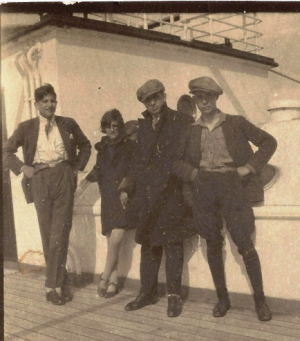
On the boat from Constantinople to Brindisi (1927). Left Albert Hatem (coll. Tico Hattem)
Uncle and aunt
Maurice Eskanasy (see IV.6), an uncle of Albert Hatem, already was in the Netherlands. Maurice was married to a sister of Alberts mother, Rifka ('Rebecca') Capuano. In Turkey during those days it was common that acqauintances were informed if somebody was about to arrive. During his walk from the Central Station to the Nieuwe Achtergracht someone loudly shouted 'Mois Eskenazi'. For Albert this was the signal that his uncle had called that he had arrived. Albert rushed to the man who shouted 'Mois Eskenazi'. But it was a vegetable seller who had shouted 'mooie spinazie' (fine spinach). Albert did find his uncle, and started working at Perez Oostersche Tapijten (Oriental carpets).
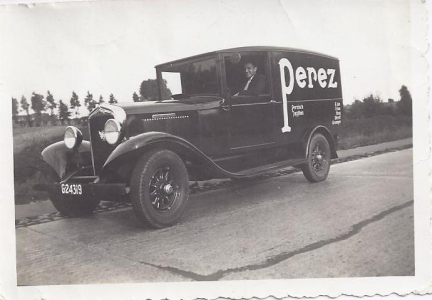
Albert Hatem in a company car of Perez, around 1930. (coll. Tico Hattem)
Addresses in Amsterdam, Haarlem and Arnhem
Albert Hatem was registered on 2 July 1928 in Amsterdam, possibly at the Korte Amstelstraat 1 boven (upstairs). This is the first address of his sister and parents, who on 12 March of the following year were registered on a 'gezinskaart' (family card). Later on they found a house at the Admiraal de Ruijterweg 32, while Moïs was registered at the 1e Helmersstraat 127. During the war the address at the Admiraal de Ruijterweg was kept. It had two exits which could come in handy, according to my father.
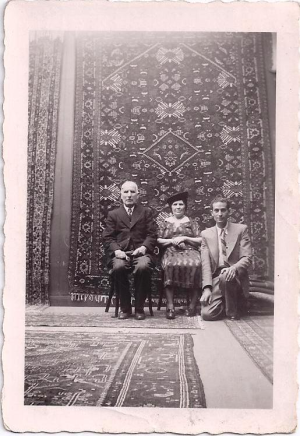
Jako, Fani Hatem and Mois Alyon in the Haarlem shop (coll. Tico Hattem)
On 15 September 1934 my father established himself at the Grote Houtstraat 104-106 in Haarlem. Meanwhile he had started to write his name in a Dutch way with two t's: Hattem. There he had a shop in Oriental carpets, where he had carpets on consignment from Perez. Semaria (Mario) Gabay (Istanbul, 1915) lived at the same address. Mario was married to a Dutch woman, Dina Smeer (1918) and worked for Hattem in the shop (see II, 6-8). Between May and October 1929 Albert lived for a short while in Arnhem, Willemsplein 20, the station square. All the time the family tried to spread the risks, that they knew well from being a Jewish minority in Turkey.
Friends
Meanwhile a close friendship with other Turkish Jews had developed. First of all there was Leon Mizrahi from Kartal (26 May 1912), and from Gallipoli the brothers Robert (11 March 1905) and Albert Yohaï (6 Dec. 1911) with their sister Louna (1 Nov. 1910).
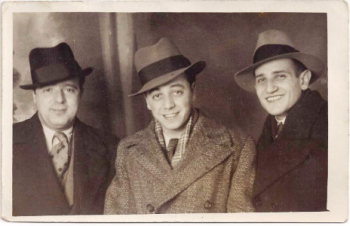 |
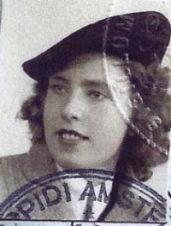 |
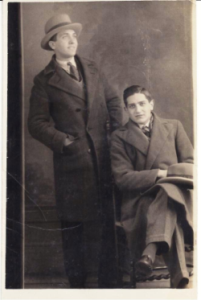 |
Albert Hatem was the only one with a car, a Dodge, and friends and family made many trips in and outside the country, for instance to Paris. Anna ('Annie') Elizabeth Kennedy (Amsterdam, 6 Feb. 1917), who had no religion, got steady with Albert Hatem. They were modern and lived together, but because of the threatening situation postponed a marriage. They were advised against it by a Dutch civil servant. Her Dutch passport, from 24 June 1939 and valid for two years, shows an attractive woman wearing a stylish baret.
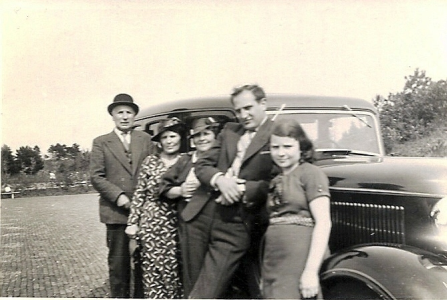
Jako and Fani Hatem, Rebecca Eskenasy, Albert and Mari Hatem with the Dodge (coll. Tico Hattem)
Survival tactics
The group of Turkish Jews was raised and used to not behave as a Jew to the outside world. This was because in Turkey they never knew which side the Turkish government would choose (and nowadays this still holds in a lesser way). They formed a tightly knitted group, who stayed a lot together, protected each other and gave little information to the outside world. The most outside contacts were with other minorities from the former Ottoman Empire, like Greeks (Kosta) and Armenians. From a young age, the Turkish Jews made these survival tactics their own.
Military service
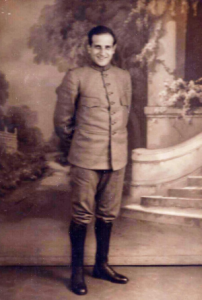
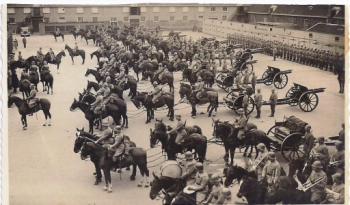
Albert Hatem as artillery man --- Army camp of the Mounted Artillery with music band near Haarlem (coll. Tico Hattem)
To become naturalized my father, as the only one from the circle of friends, voluntarily joined the army. On 16 January 1936 he entered service at the unmounted part of the Mounted Artillery. From the service papers my father knew that 'the decent fulfillment of the military service as such, would not lay claim to the favor of naturalization at no cost or low cost.' Still he found it worth a try. Albert stayed in service for five and a half months.
Turkish and Dutch documents
There are a couple of documents from my father Albert. It is important to know them in order to understand his position as a Turkish Jew living in the Netherlands.
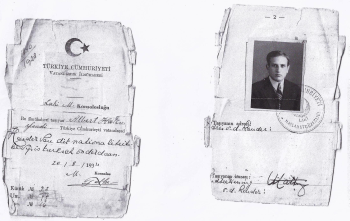

Turkish passport of 20 August 1934 of Albert Hatem, p.1, p.2 en p.12-13 (coll. Tico Hattem)
- A Turkish passport, issued by the The Hague consulate ('Lahi') on 20 August 1934, with a handwritten Dutch translation of the Turkish text, including the term: 'Proof of Turkish citizenship'. According to the stamps it is known that he was registered in the capital on 2 July 1928 and then moved to Haarlem on 9 October 1934. Just as earlier in Amsterdam, he there received from the Foreign Police a renewal of his residence permit for half a year. Albert signs with 'A. Hattem'.
- A handwritten document of 25 December 1938 of the secretary of the Turkish consulate, stating that according to the Cabinet meeting on 07-07-1938, his Turkish nationality has expired.
- On 27 October 1940 he applies to the government; the content is not known to me. Perhaps Albert wanted to apply for the Dutch nationality. At that moment he probably did not know that, despite the Cabinet meeting, he still was protected as a Turkish citizen.
- On 22 March 1941 a request for naturalization follows.
- On 14 January 1942 he receives a notification by the Reichskommissar, who asks for his nationality. As a reaction to this letter, Albert and his brother-in-law Moïs Alyon, immediately that day have their Turkish nationality checked and confirmed by the 'Wirtschaftsprüfstelle', the company control service (19 January 1942). They obviously keep silence about the documents and applications aimed at their naturalization.
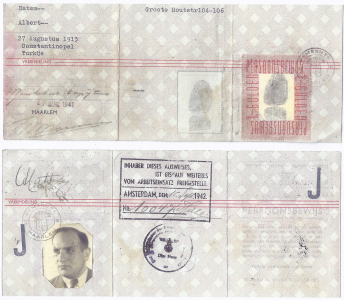
(coll. Tico Hattem)
- An identity card with a J (for Jew) and the term 'vreemdeling' (foreigner) handed out in Haarlem (27 Aug. 1941). Albert is 'carpet merchant' and lives at the Grote Houtstraat 104-106. A stamp of 15 September 1942 states that he is exempt from Arbeitseinsatz (forced labour). At some point during 1942 Albert, in a street in Amsterdam, is run in and interviewed by the S.S. in the Euterpestraat. But his Turkish documents, with his address in Haarlem, protect him.
- Early 1943 this Turkish protection ends. Albert and his mother end up on two German lists of February of that year, which say their Turkish documents have been ceased. They have to go into hiding.
During the first years of the war all Jews from Turkey with Turkish documents had a privileged position. From 1 January 1943 this position discontinued. Possibly the carpet shop of Albert Hattem in Haarlem was open during the early years, because there is a trading permit from 1 March 1941 until 1 January 1942. In October 1940, like all Jewish merchants, Albert had to register his business with the 'Wirtschaftsprüfstelle', to have it 'Aryanized'. In the spring of 1941 a non-Jewish administrator was appointed. In August the money had to be transferred to the Liro-robbing-bank. What could one do against such injustice? I am sure the stock of the shop was hidden. One of the hiding places was at the Amsterdam Leidsekade, where Agatha, the sister of Annie Kennedy, lived with her husband Chris Reumer. The Dodge also was dismantled and hidden. After the war the car was used for seven more years.
Death of father Hatem
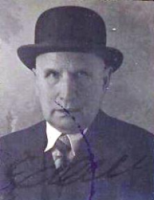 |
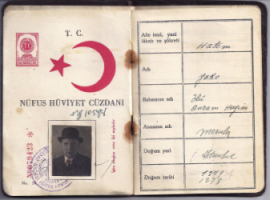 |
 |
Jako Hatem had a Turkish passport with the religion 'Judaism' (Musevi) written in. The names of his parents, Avram and Merula, and of the woman he was married to ('Fani ile evli') also could be an indication for it. Still he had the intention, witness to the passport photo's kept, to apply for a Dutch passport. This never happened. On 13 September 1942 Jako Abraham Hatem dies. He is buried in the Portuguese-Israelite cemetery at Ouderkerk aan de Amstel; on his grave is an epitaph in Hebrew. My father told me, he was the only one behind the bier, walking from the 'Snoge' at the Jonas Daniel Meijerplein to Ouderkerk. For safety reasons no friends or relatives accompanied him.
In hiding
Annie Kennedy, Alberts girlfriend and my mother, rented in 1942/1943 the shop at the Beethovenstraat 62 with living quarters, bedrooms and workshop at the back. In the shop they established a ladies' fashion company with its own workshop. A building, again, with two entrances. Here, during the first months of 1943 when they were not protected by the Turkish state anymore, Albert, his mother, sister and brother-in-law, a cousin and two friends went into hiding.

Click on the drawing to enlarge (coll. Tico Hattem).
I can exactly describe this location, including the camouflaged hiding cellar. This went on beneath the entire building and also provided access to the neighbouring house at nr. 60. It was about 80 cm in height. In the cellar the ones in hiding slept and also took cover during danger or during air-raid alarm. The entrance to the cellar - see the star on the drawing - even existed until 1964! The people in hiding cooked on a 'miracle-burner' that also serviced as a heater. Entire fences disappeared into this burner.
Hunger
To get food Anna Elizabeth Kennedy, as long as her pregnancy made is possible, went into the countryside by bicycle to exchange Persian carpets for food. One time she was in Haarlemmerliede and asked a farmer for some potatoes. He didn't want to, but his son said: 'Do give that poor woman some potatoes'. It was Barend Biesheuvel, who was to be the Prime Minister of the Netherlands during the seventies. At the Beethovenstraat nr. 60 was a greengrocer, where they regularly pinched small amounts of food. They reached his supplies through a hole in the cellar wall, and then upstairs.
Incident
During the day they were in the back living room where the workshop was (upper left on the drawing) and they made themselves useful by sewing clothes together and make alterations. They were trained to disappear in the blink of an eye to the basement.
One time it almost went wrong. At that day two German military men came into the shop and announced 'You have Jews in hiding'. There already was a customer in the shop and Anna asked the military if it was alright when she first quickly finished with the customer who came to collect her altered clothing. The customer, who did not come to the shop for alterations, played along. Quickly my mother went to the workshop to warn her friends. Meanwhile she closed the communicating door (as a precaution the lock was super oiled and made no noise at all). The refugees rapidly disappeared in their hiding place. The customer was given a piece of clothing and the Germans took no further action, convinced by Annie's cool behaviour. She was invited by one of the Germans though, which she refused by saying she already had a boyfriend.
No star
The ones in hiding knew about the deportations very well and, contrary to what most of their fellow-countrymen believed, were convinced this would end in death. They never bore a Star of David and agreed that in this situation, when someone would be coming for them, they immediately would attack. They were going to die after all, they reasoned. They also had a big mortar ready for striking. Eventually all the ones in hiding and Anna Elizabeth survived the war.
Who were the ones in hiding?
There were seven: Albert Hatem, his mother Fani Hatem-Capuano, his sister Mari Alyon-Hatem, her husband Moïs, cousin Jacques Eskenazi, son of uncle and aunt Eskenasy-Capuano, and two friends: Leon Mizrahi and Albert Yohaï.
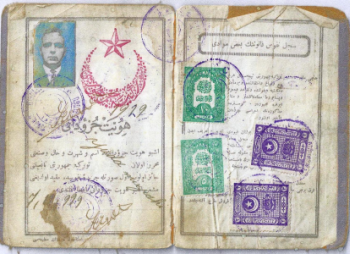
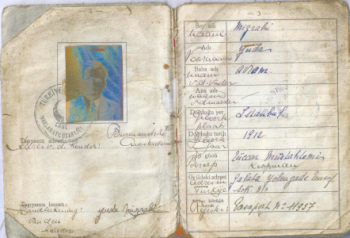
(coll. Tico Hattem)
The family kept several documents of Leon (Istanbul-Kartal, 1 May 1912), officially named Juda (see below): an Ottoman-Turkish pass from 1929, in Arabic writing, a Turkish passport from 1935, with the address Burmanstraat 20-III, and a forged Belgian identity card (issued in Norg) in the name of Leon Offermans, with a moving date of 12 February 1942 to the Beethovenstraat 146-III. That was not far from the hiding address.
Births
On 16 December 1943 Fanny Alyon was born. Seven months later Anna Elizabeth gave birth to a daughter, Mary (20 July 1944). Her brother-in-law Chris Reumer, confidant of the ones in hiding, registered the girl with the Registry of Births, Deaths and Marriages as 'Mary Kennedy'. After the war she was able to get her real name, Mary Hattem.
After the war
Albert Hattem (now written with double t) and Anna Elizabeth Kennedy marry shortly after the war. They have a second child, Albert Jacques ('Tico'). Leon Mizrahi, Albert Yohaï and Jacques Eskenazi marry to non-Jewish women. By now all the persons in hiding have deceased. All of them had children.
- Fani Hatem-Capuano dies on 23 April 1947 and is buried in the Portuguese-Israelite cemetery at Ouderkerk a/d Amstel.
- Mari Alyon-Hatem, who had a son 1946, dies on 2 December 1969, and is also buried at Ouderkerk a/d Amstel.
- Moïs Alyon, divorced of Mari Hatem, dies on 5 November 1974 and is buried at Ouderkerk.
- Albert Hattem dies on 8 June 1989 in Marseille and is buried at the same cemetery.
- Anna Elizabeth Hattem-Kennedy dies on 22 January 1997 and is buried in the Kennedy family grave at the Oostelijke Begraafplaats (Amsterdam.
- Juda (Leon) Mizrahi, father of Paxquita (1951) and Alberto Ronald (1953), dies on 15 December 1969 and is cremated at Driebergen-Westerveld.
- Albert Yohaï dies in 1980. He is the father of Marco (1947).
- Jacques Eskenazi, father of Carmen (1942), Peter (1947), Jacqueline (1950), Yvonne (1956) and Jolanda (1967), dies in 1990 in Alicante and is buried there. The family name becomes Eskinasi.
As kids, once a year at Memorial Day, we were told the stories of that period. The parents decided never to talk about it. That is why this story was never known to others, except for a handful of insiders.
Integrated
I would like to add that this group of Turkish Jews quickly were integrated in their new homeland and that they soon managed to speak the language. Shortly after their arrival they became independent merchants and most of them had mixed marriages. Therefore as a group the stayed unknown and almost invisible. Only the integration authorities knew where to find these 'second generation non-western immigrants'. But this also is a thing of the past for people with Turkish roots. The above can bare unburdened witness to a special piece of Dutch history."
7. Eduard Lichtenstein (1 April 1889). In 1943 he lived at the Noorder Amstellaan 3 in Amsterdam. That is all that is known about him.
8. Lia Monachimoff-Rikofski (Jerusalem, 5 June 1870). In 1943 she lived at the Narcissenlaan 16 in Heemstede, and didn't possess any papers about their nationality.
9. Sam Behar remembers there was a family with the name Maarabi.
Sources / Continue reading
Also see Verhalen:
Haci Karacaer: "We must share the stories from our past"
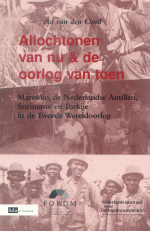
Allochtonen van nu & de oorlog van toen - Marokko, de Nederlandse Antillen, Suriname en Turkije in de Tweede Wereldoorlog
Ad van den Oord, SDU/Forum 2003, isbn 90-5409-420-6
The Dutch Red Cross, mr. Victor Laurentius
Ondergang. De vervolging en verdelging van het Nederlandse jodendom 1940-1945. Dr. J. Presser, 's Gravenhage 1965, pag. 426-427
In Dépôt. Dagboek uit Westerbork. Philip Mechanicus, Amsterdam 1964 (1989)
Mr. Rob Mayer on the Mogroby family (2005)
Mr. Sam Behar, Jerusalem, on all members of the Turkish-Jewish community (2005)
Mr. Rober Y. Yohaï on the Yohaï family (2009)
Mr. Tico Hattem, Amsterdam, on the Hat(t)em family (2012)
DutchJewry
Joods Monument
Lo Tisjkach
Oorlogsgravenstichting
Anne Frank Stichting
On Yohaï & Co Dutch Tobacco Company: Eur-Lex
www.aup.nl
www.dbnl.org/tekst
www.essex.ac.uk/wyvern
www.heritageabroad.gov
www.hfcsd.org
www.interment.net
www.jewishgen.org
members.iinet.net.au
www.ogs.nl
www.tsha.utexas.edu/handbook
nl.wikipedia.org

Please do feel free to comment on our English translation. We welcome any improvement!